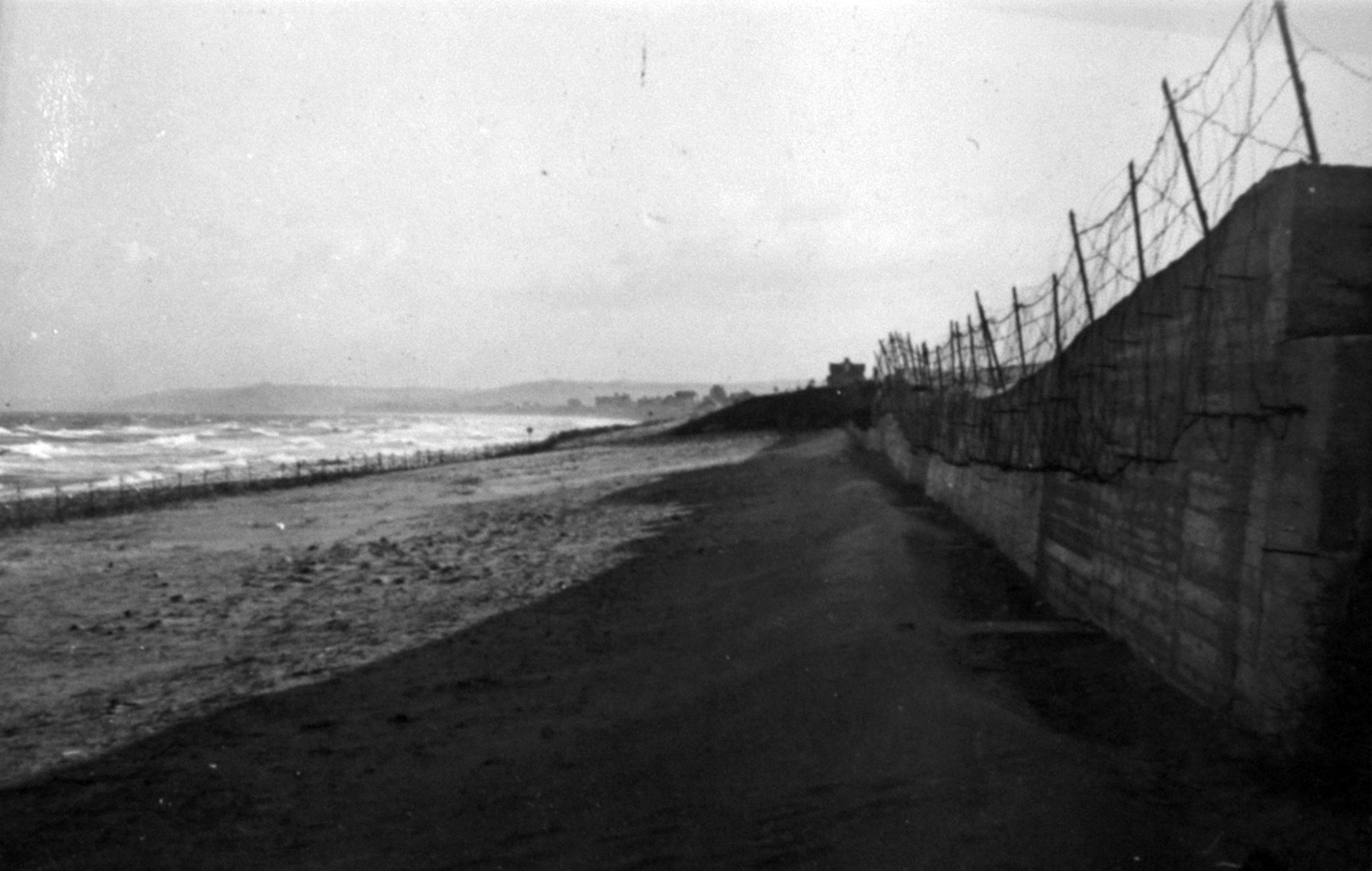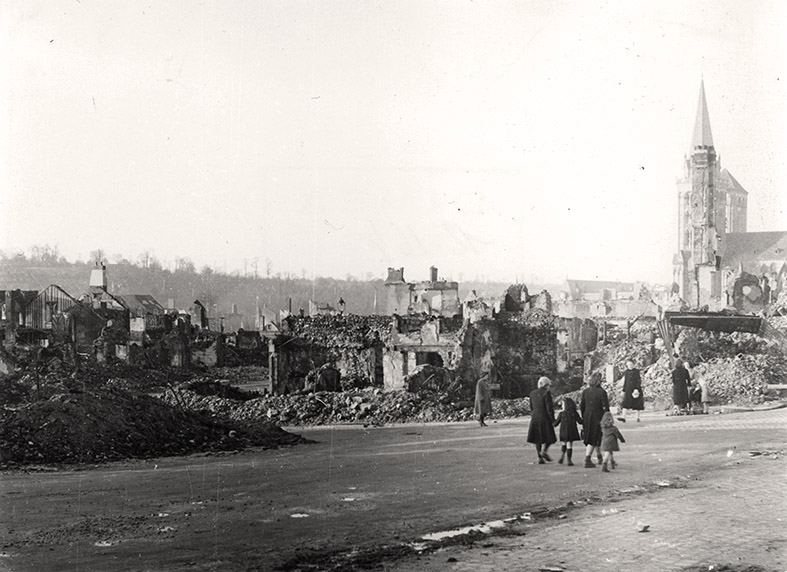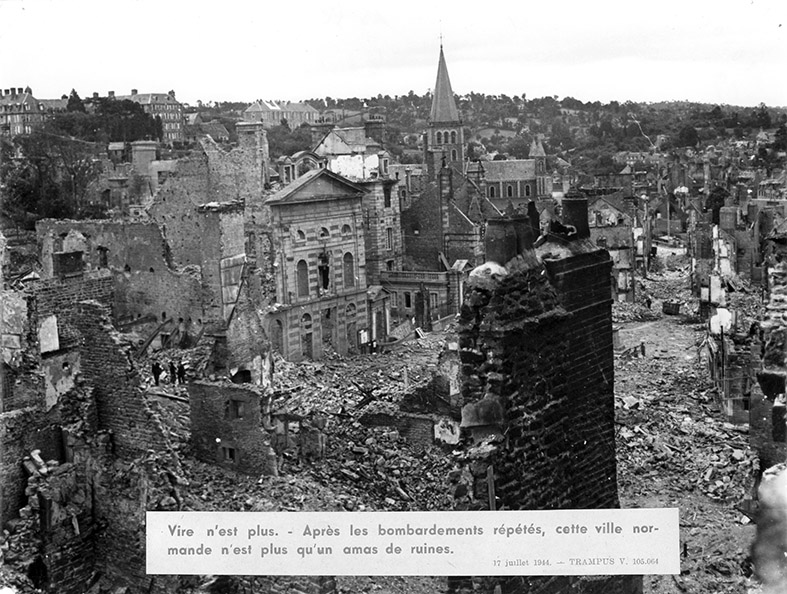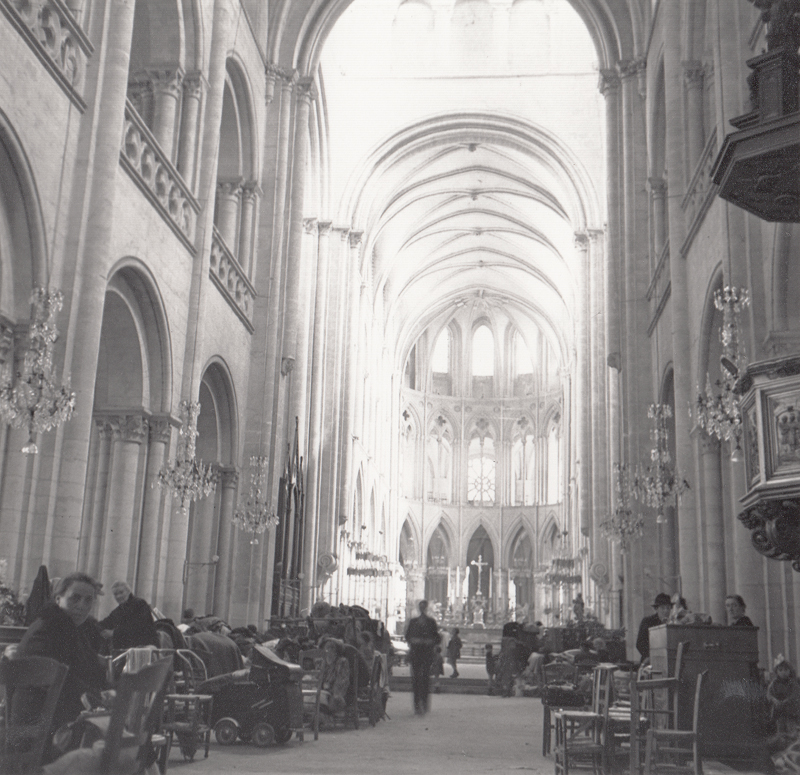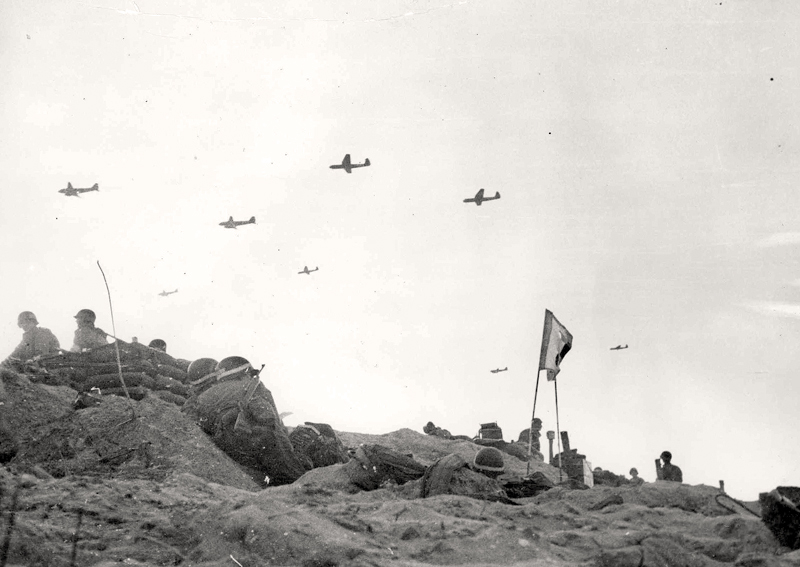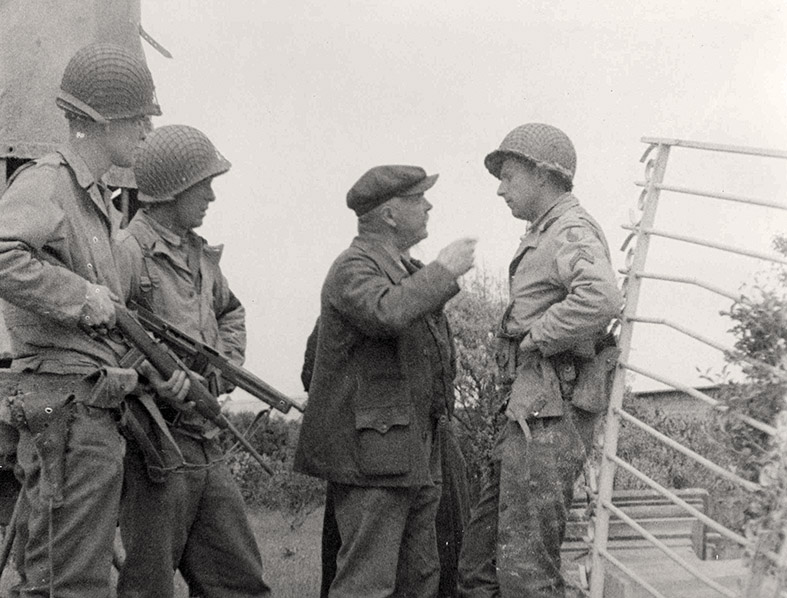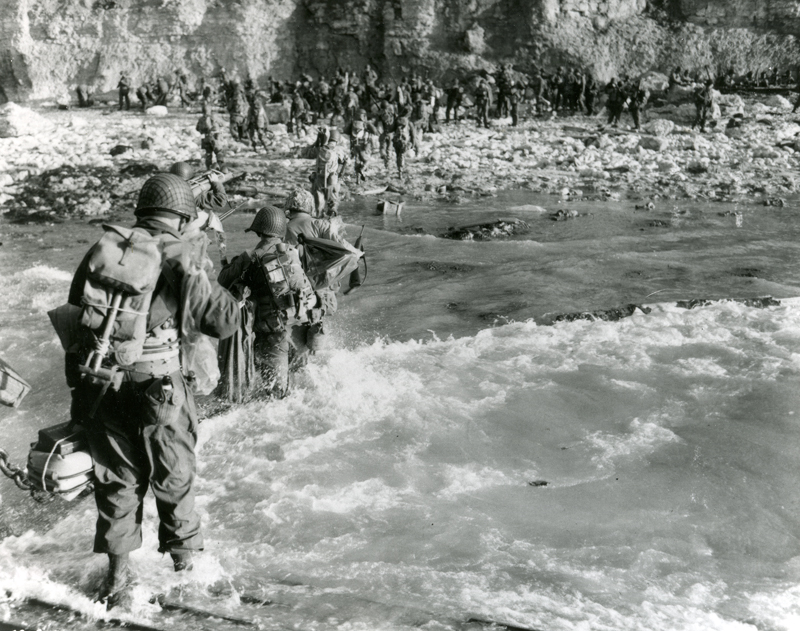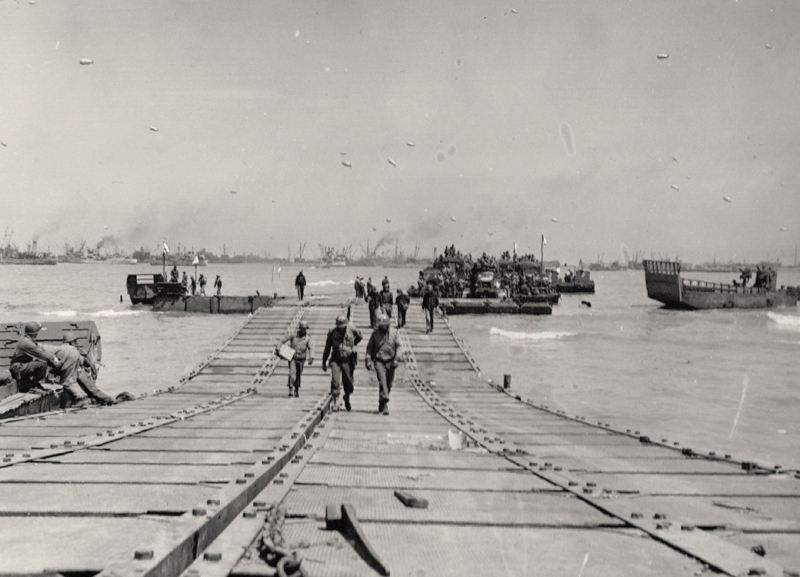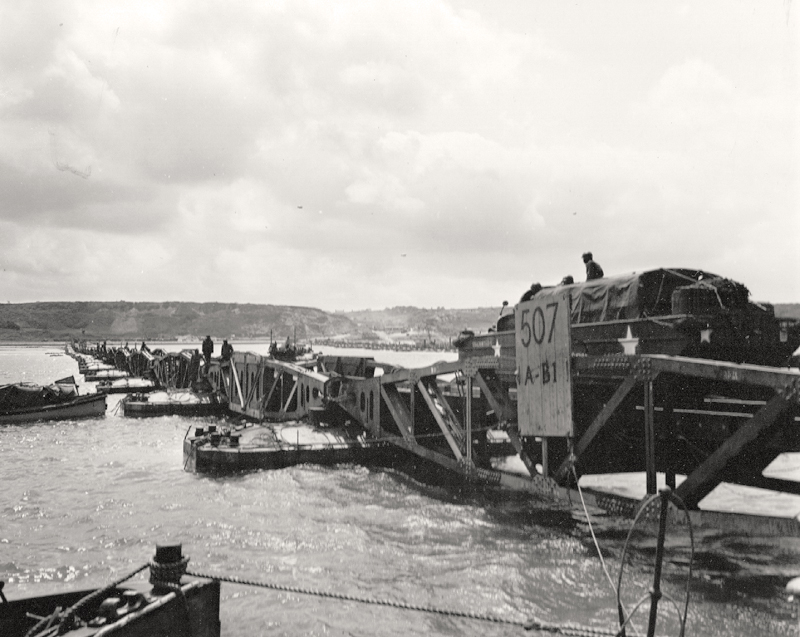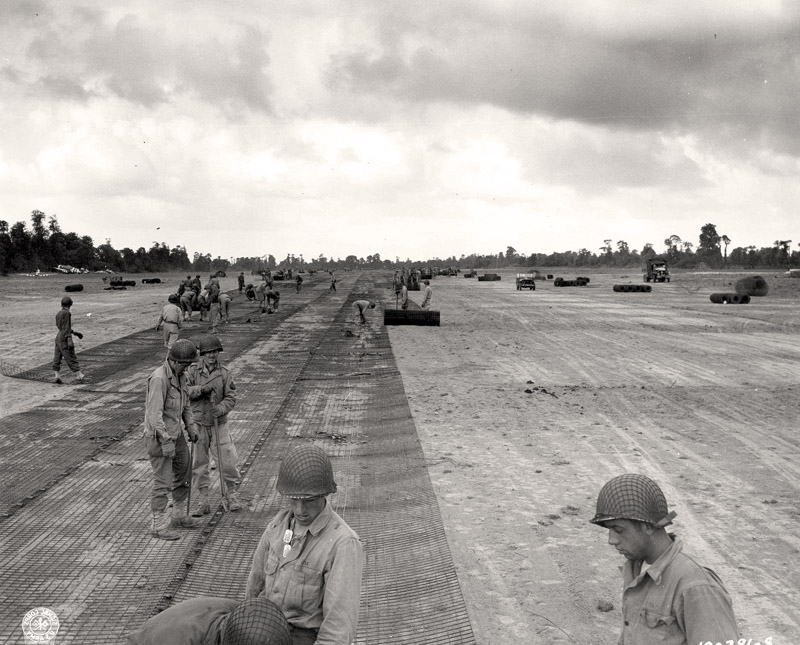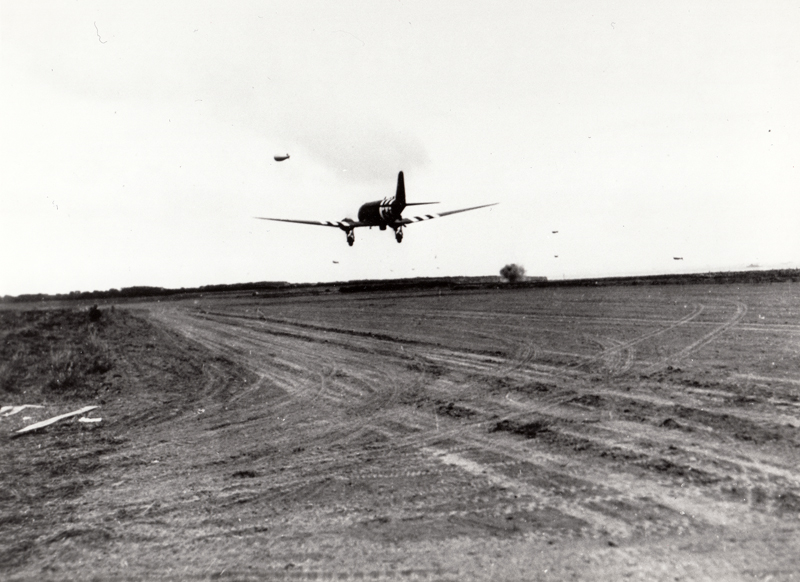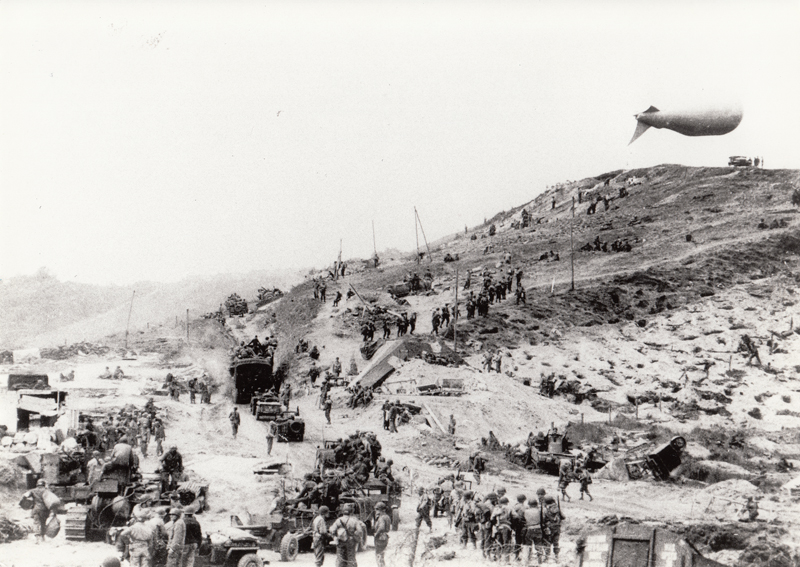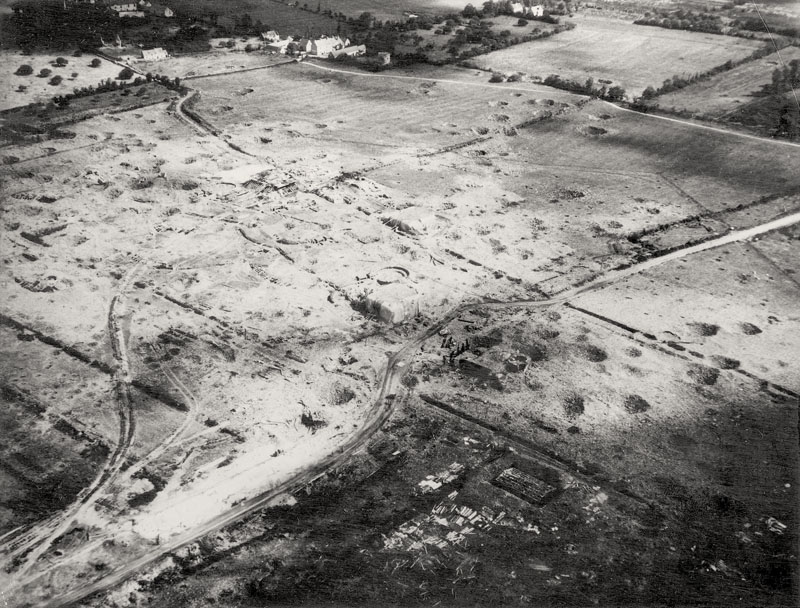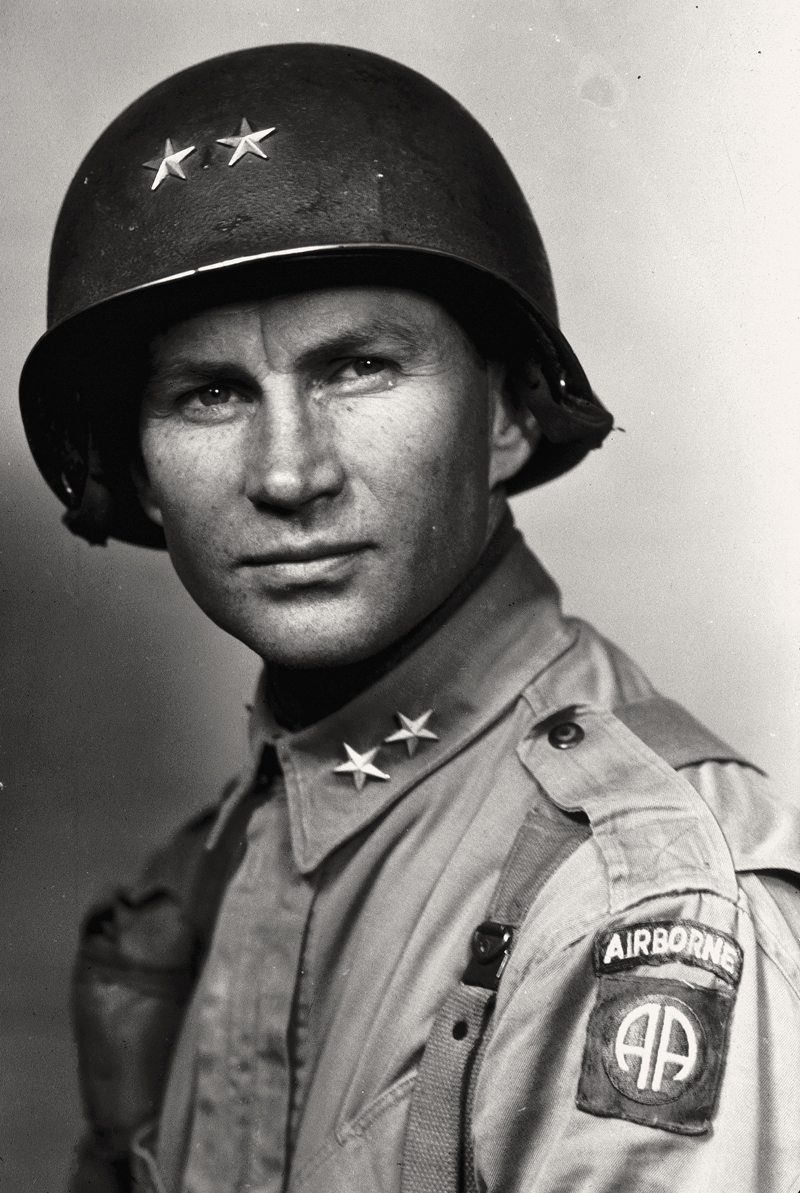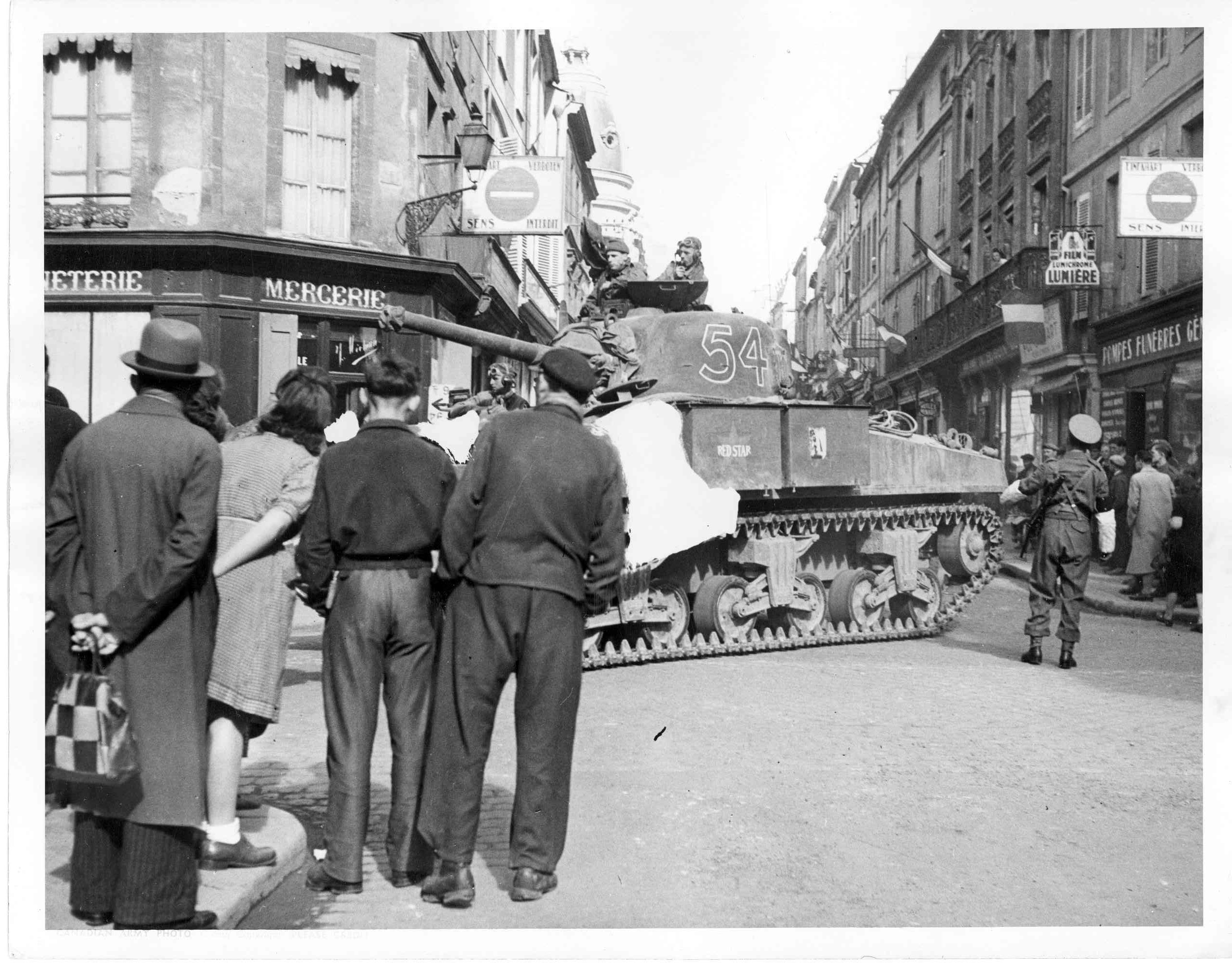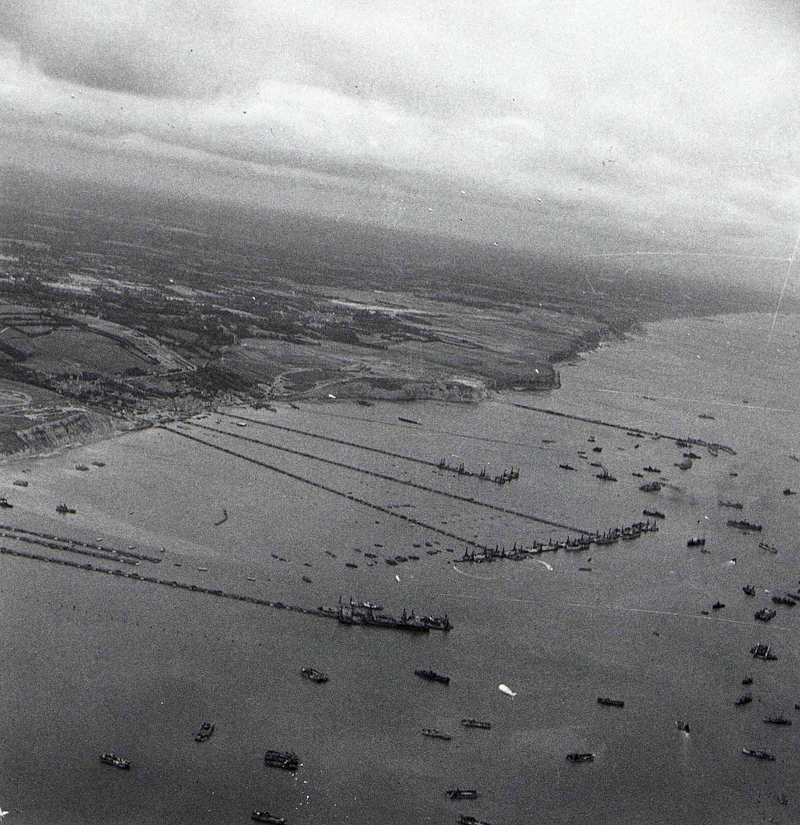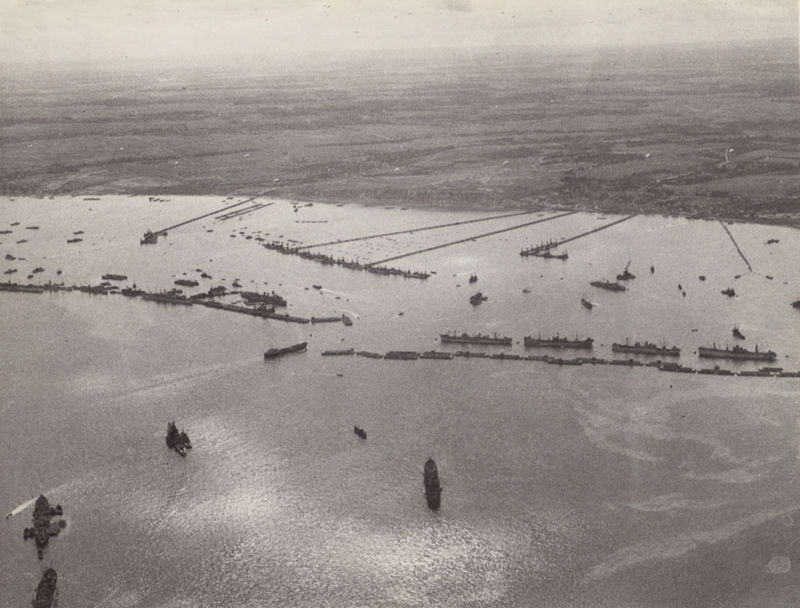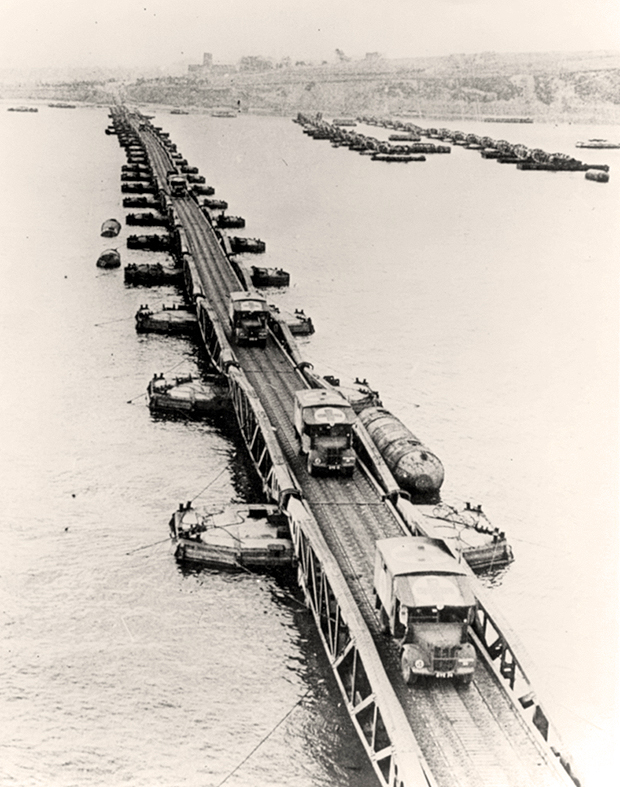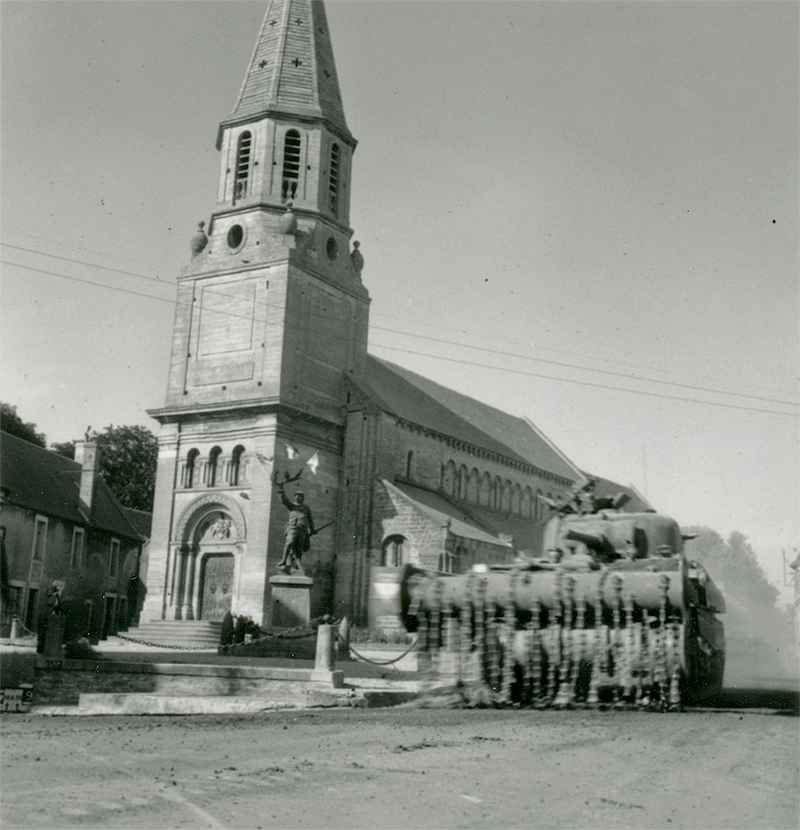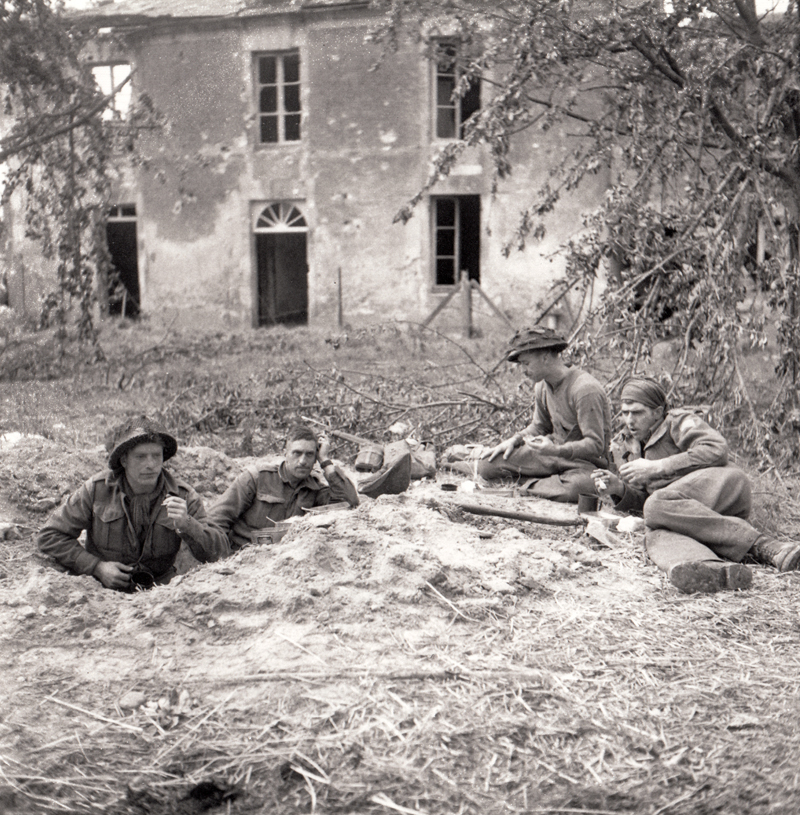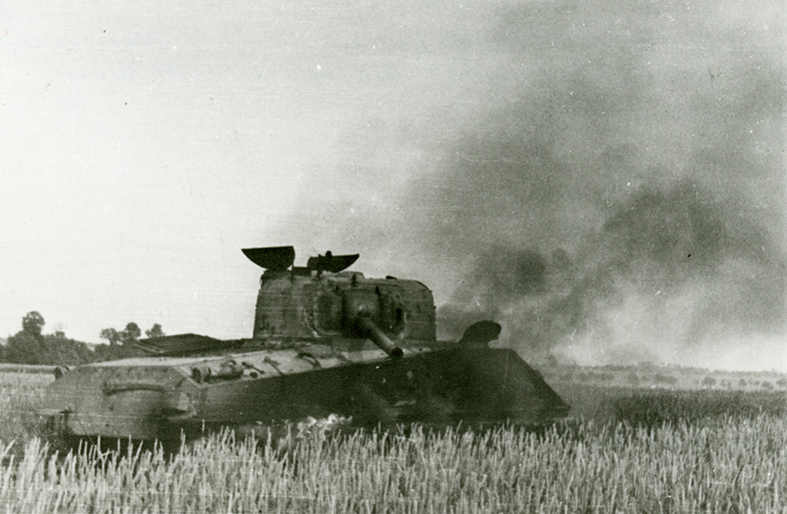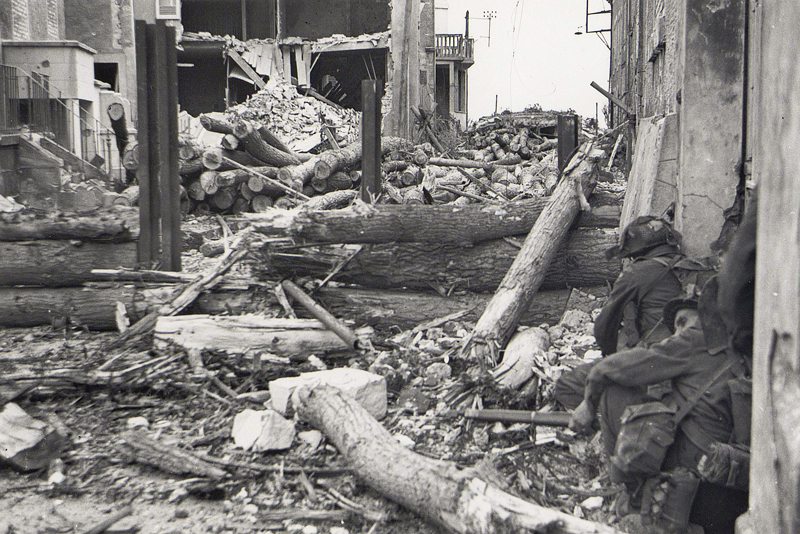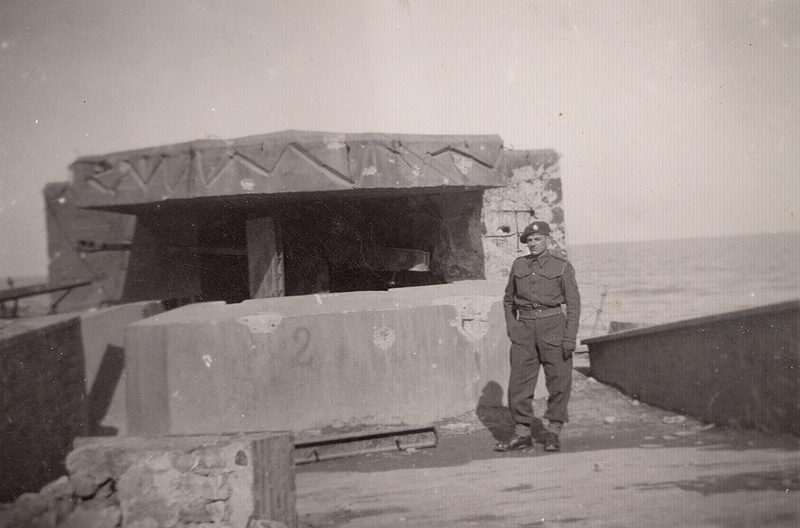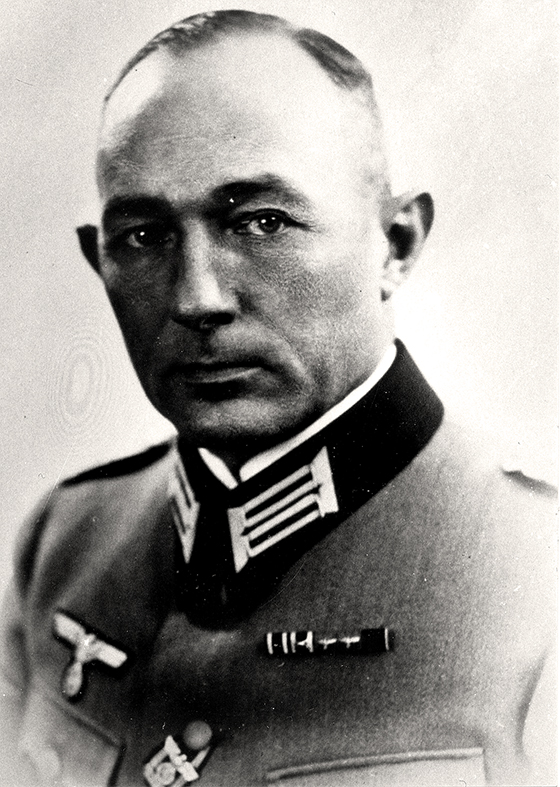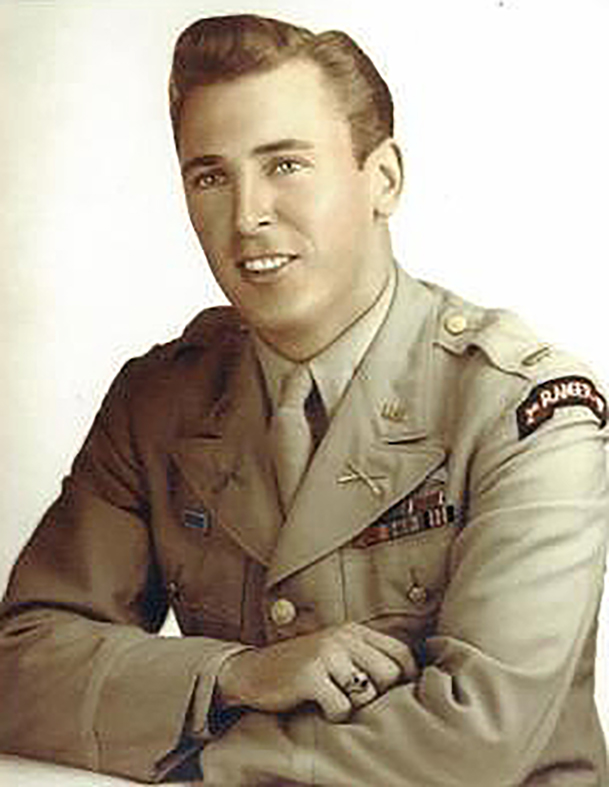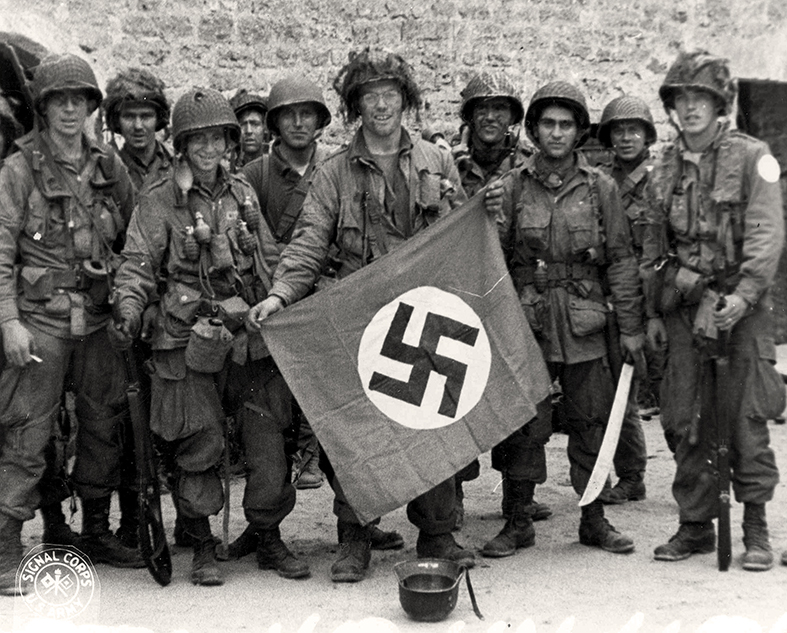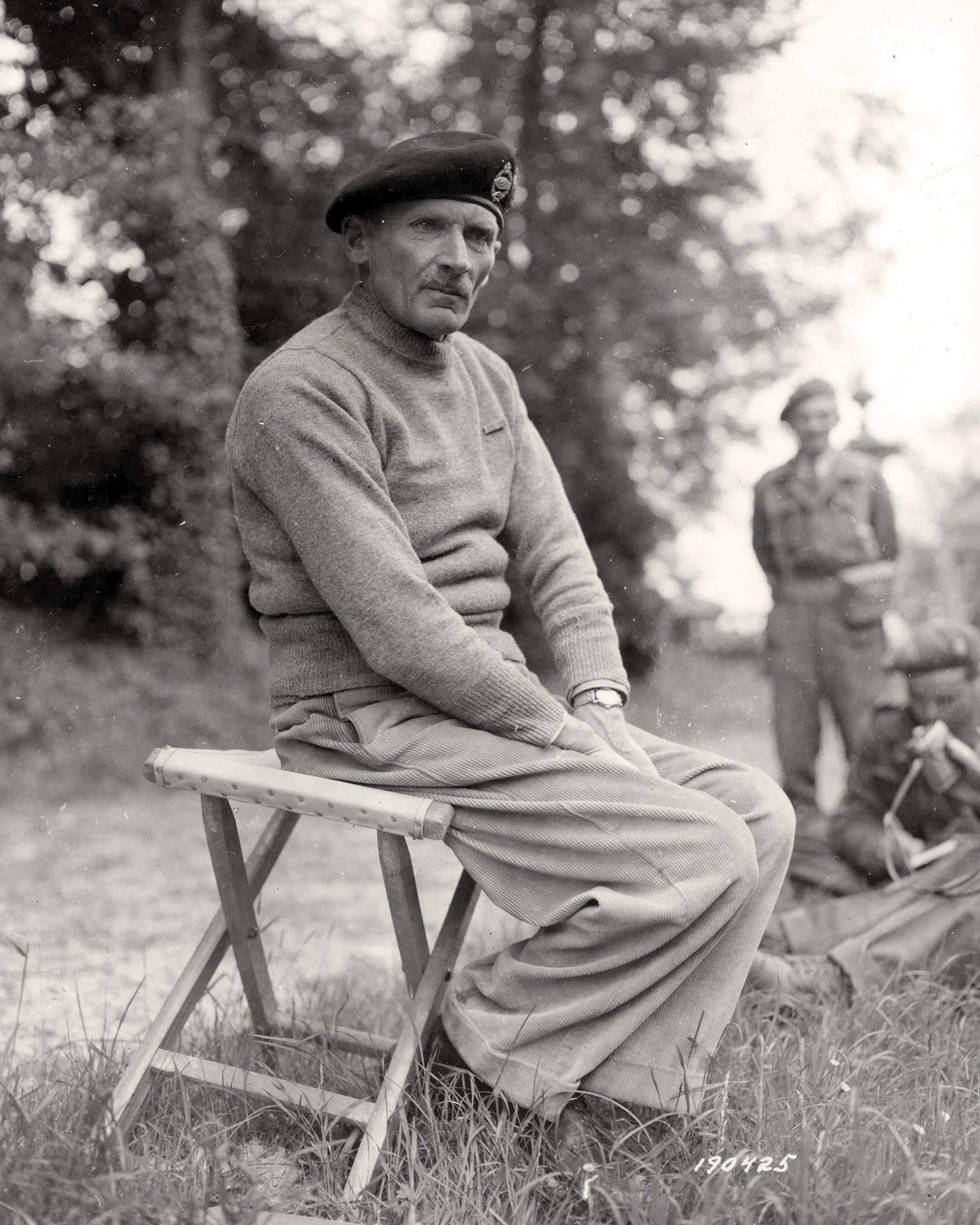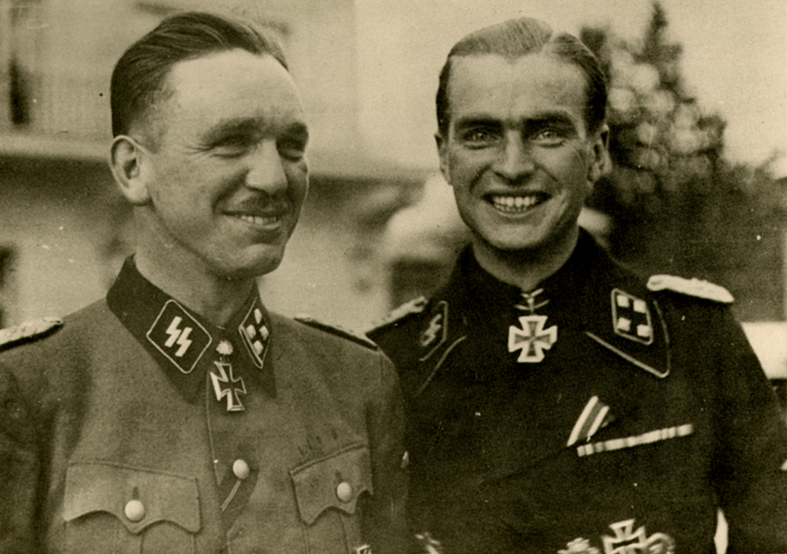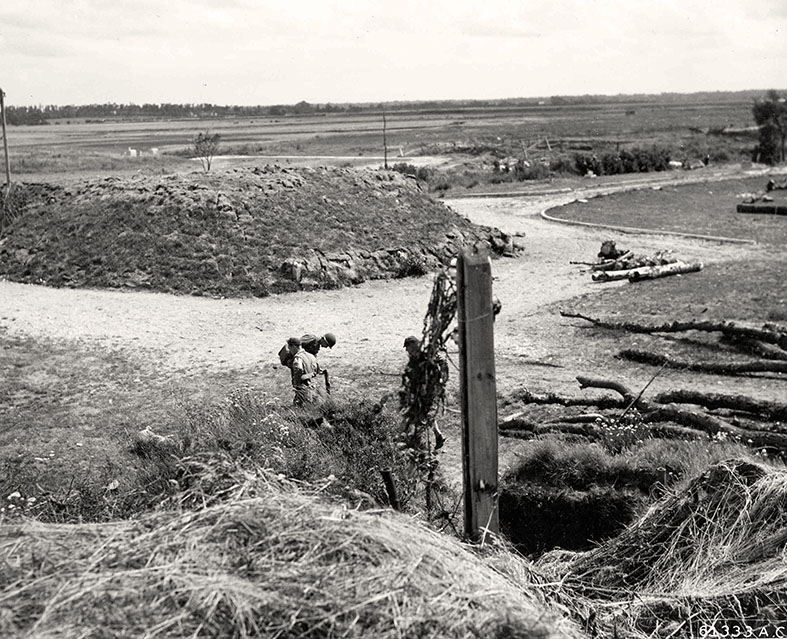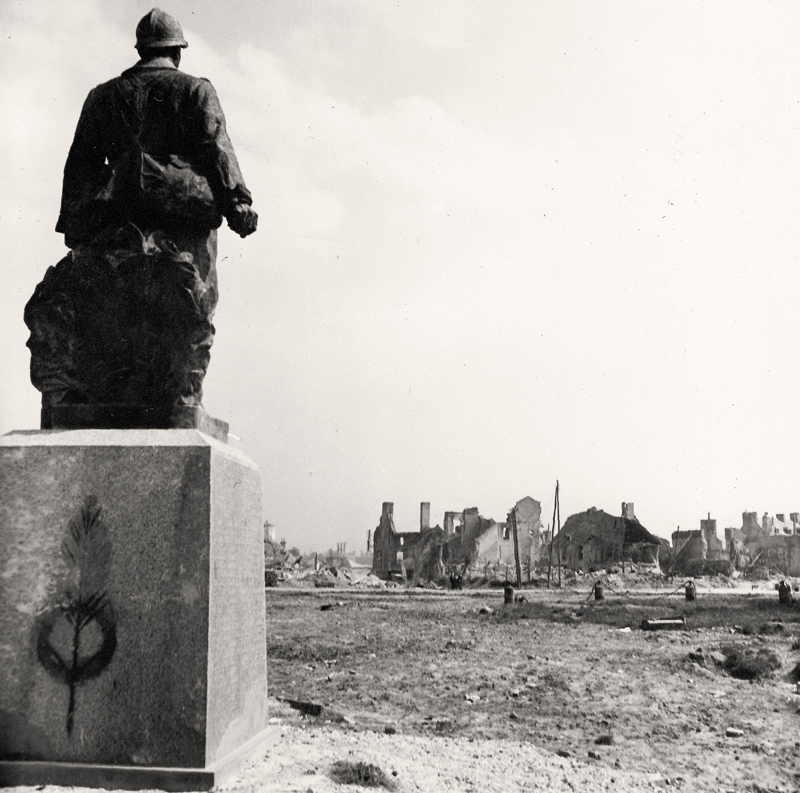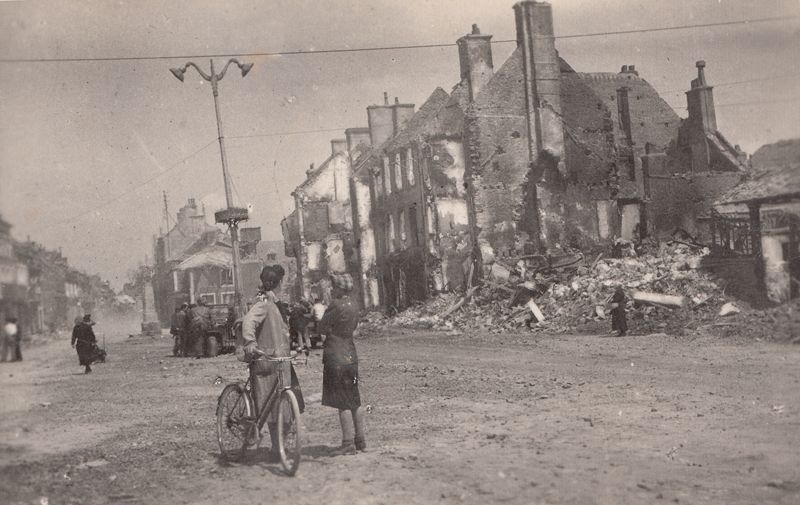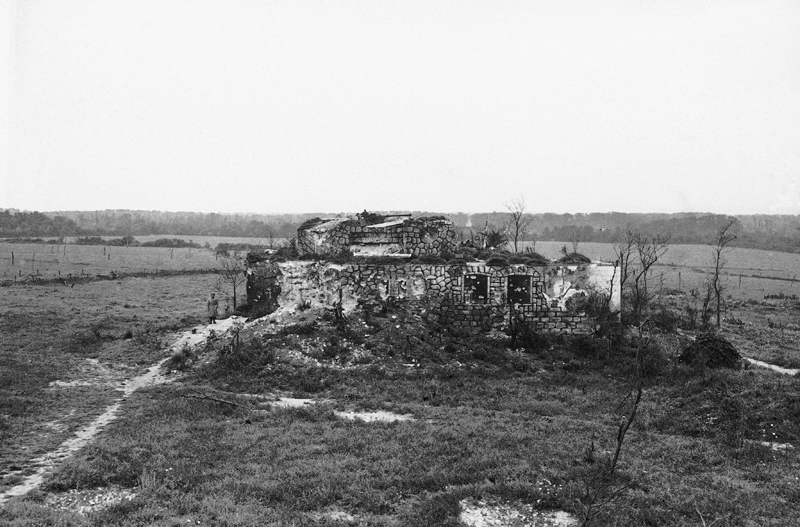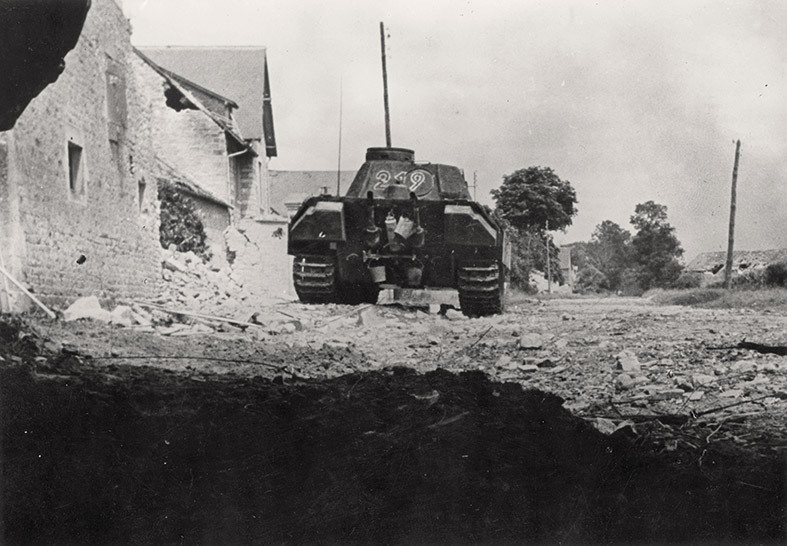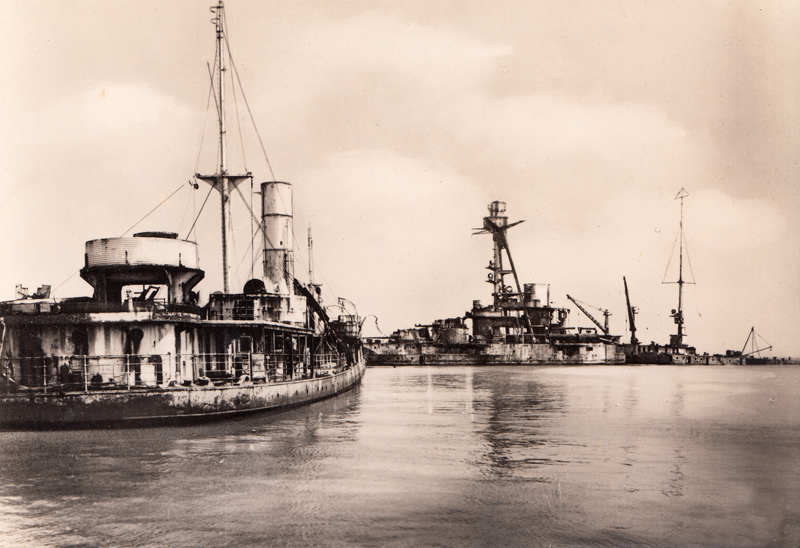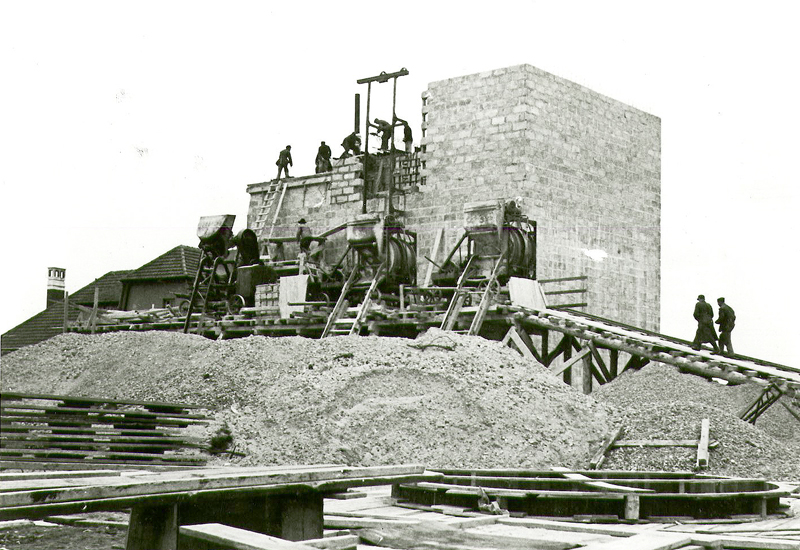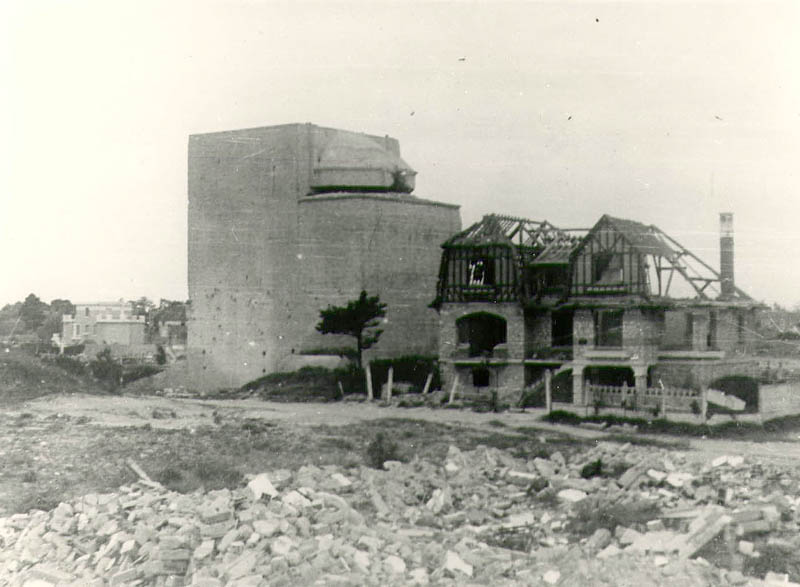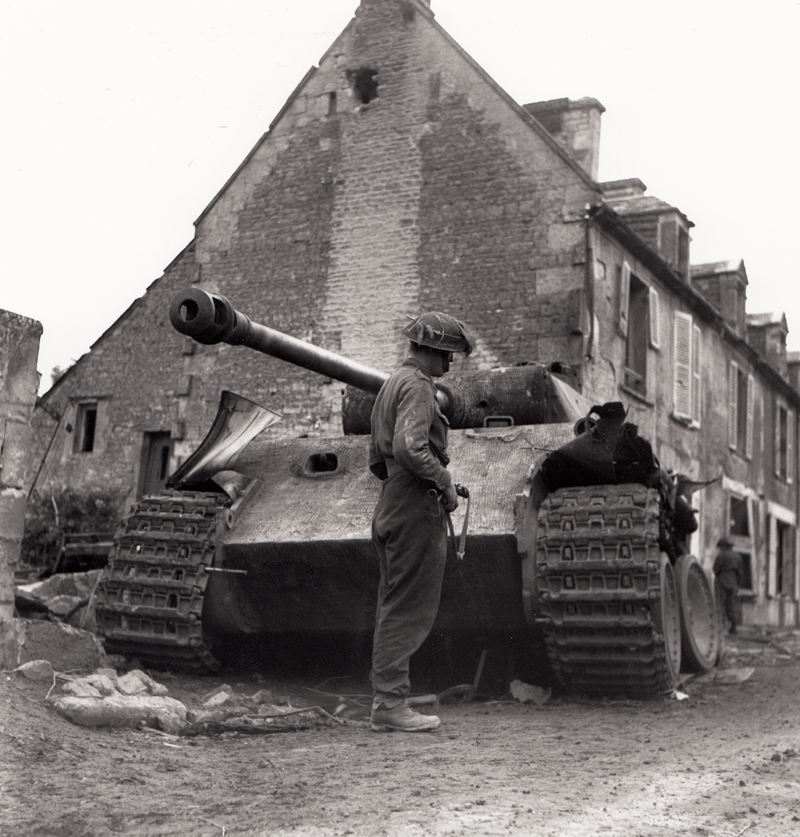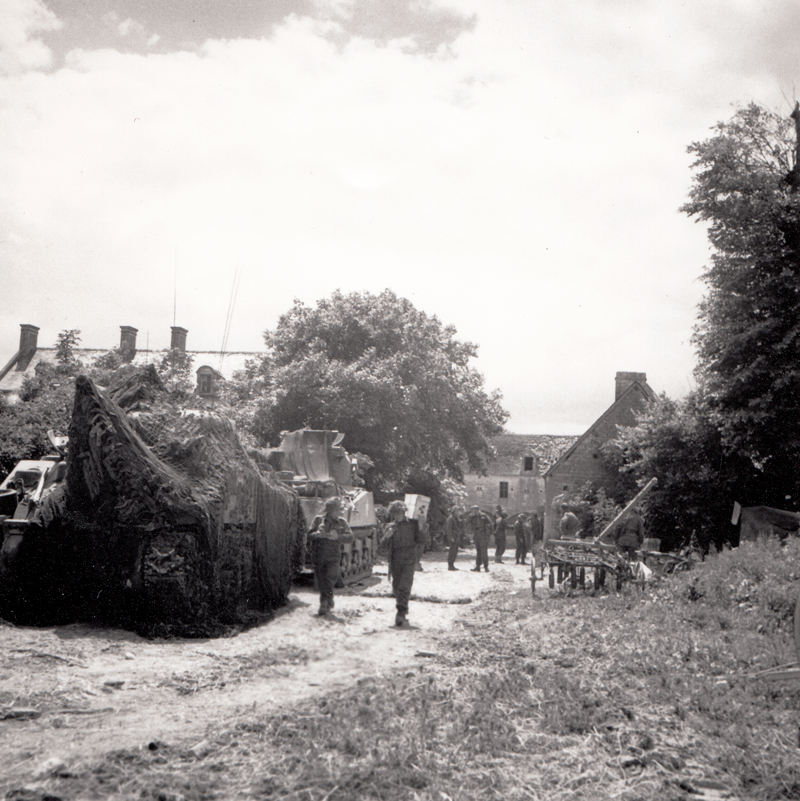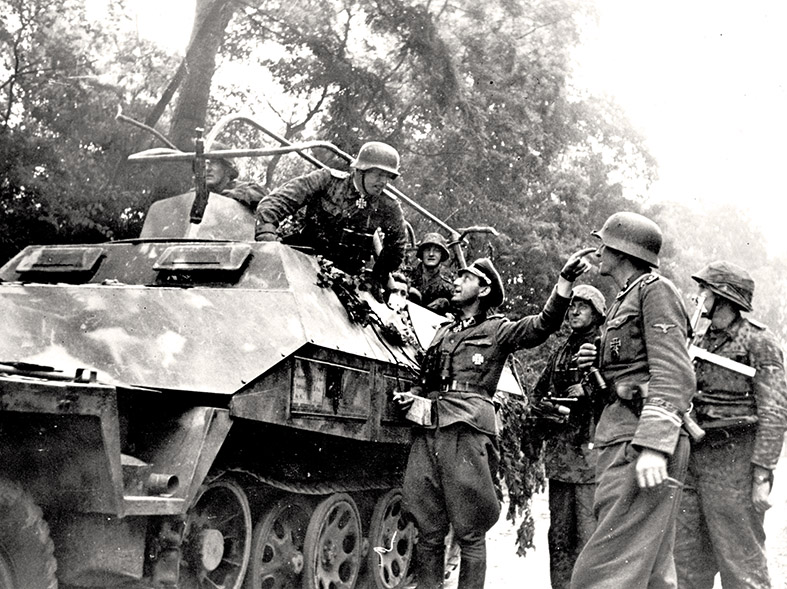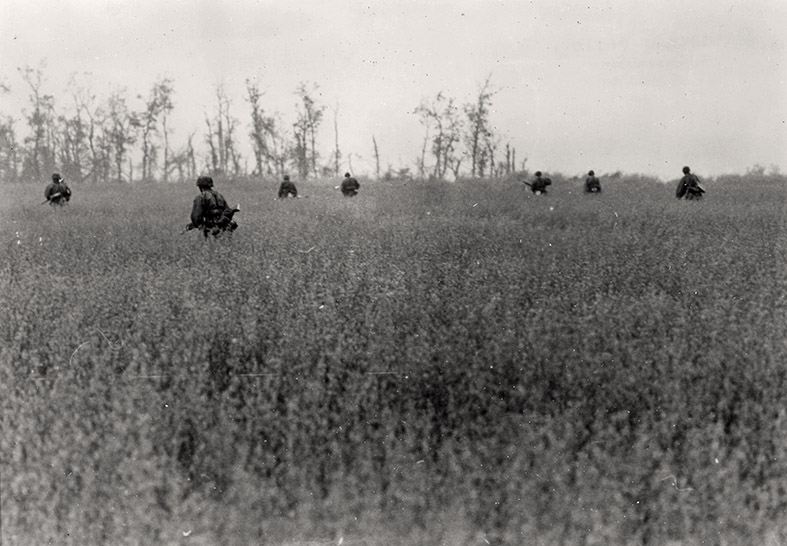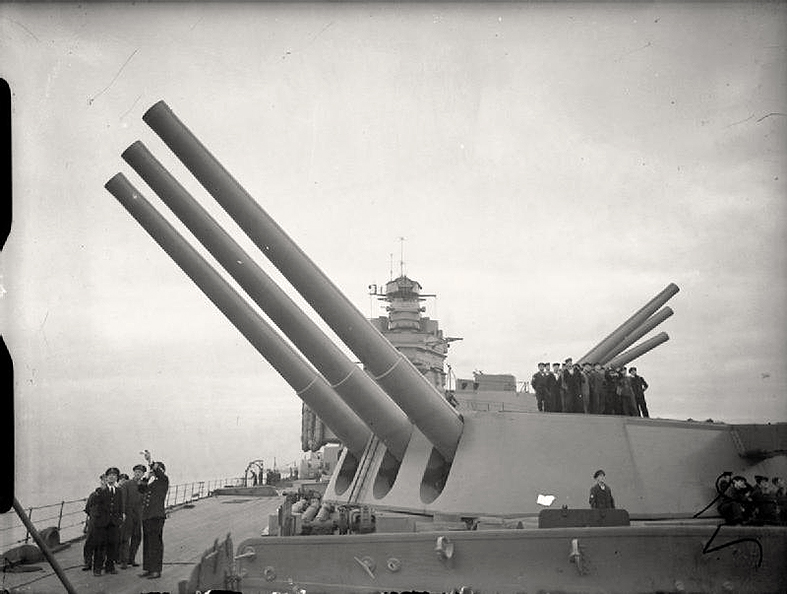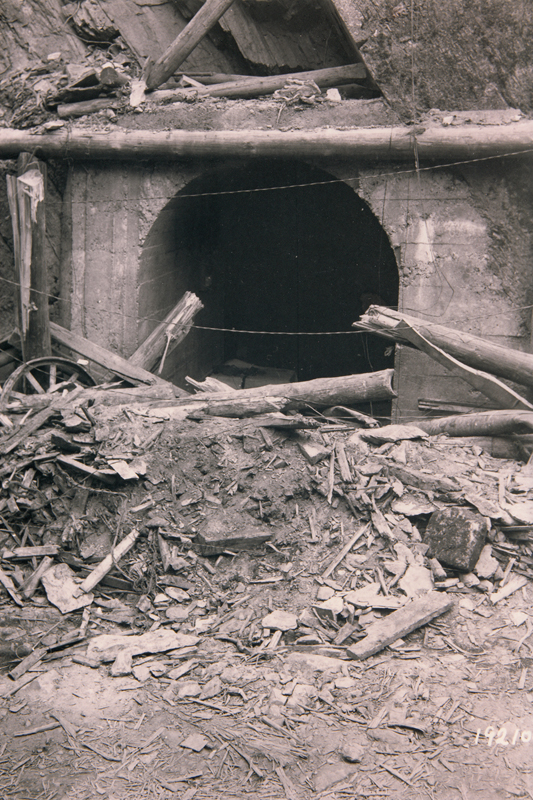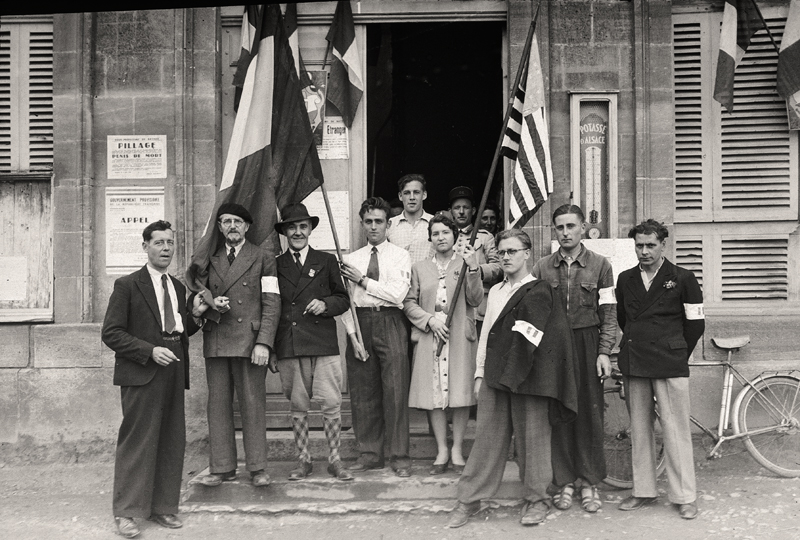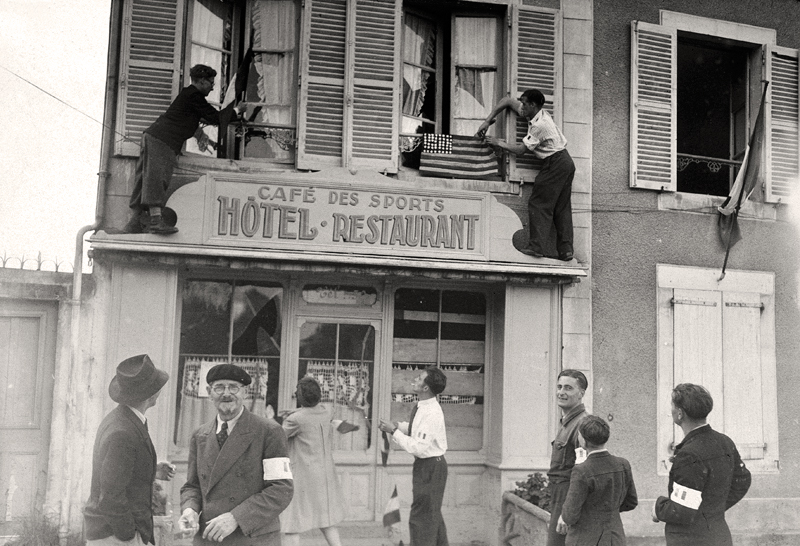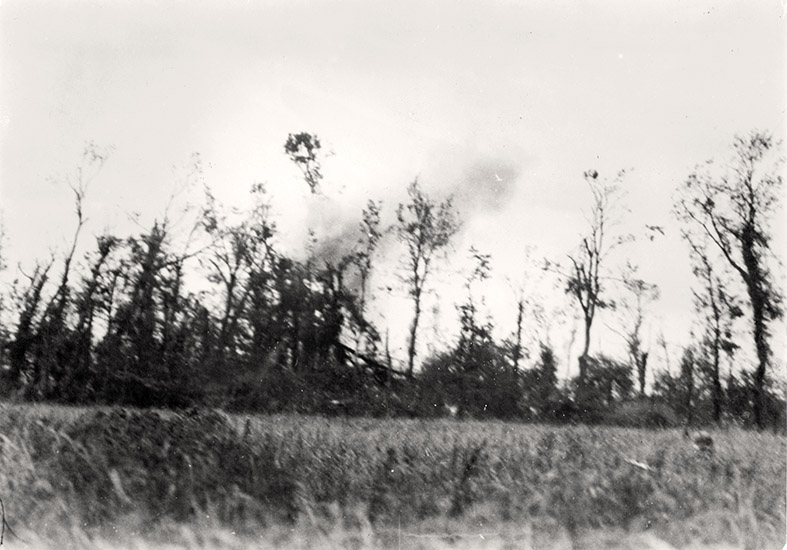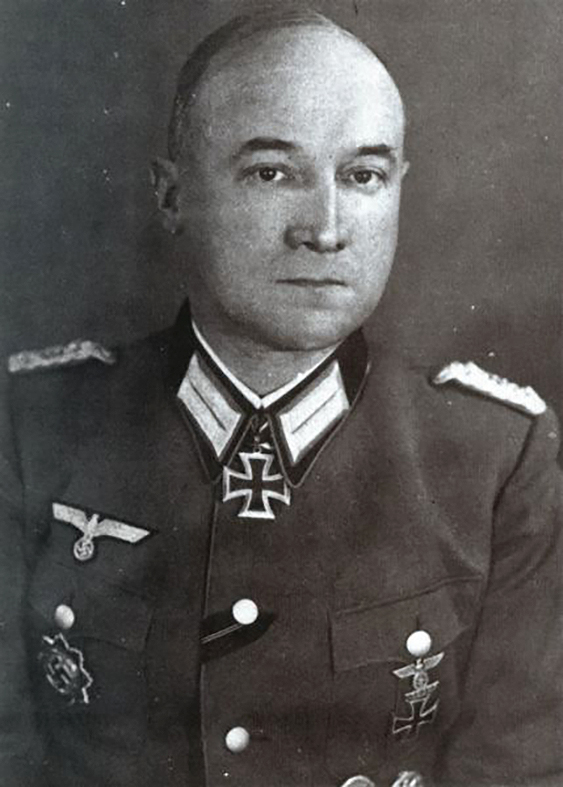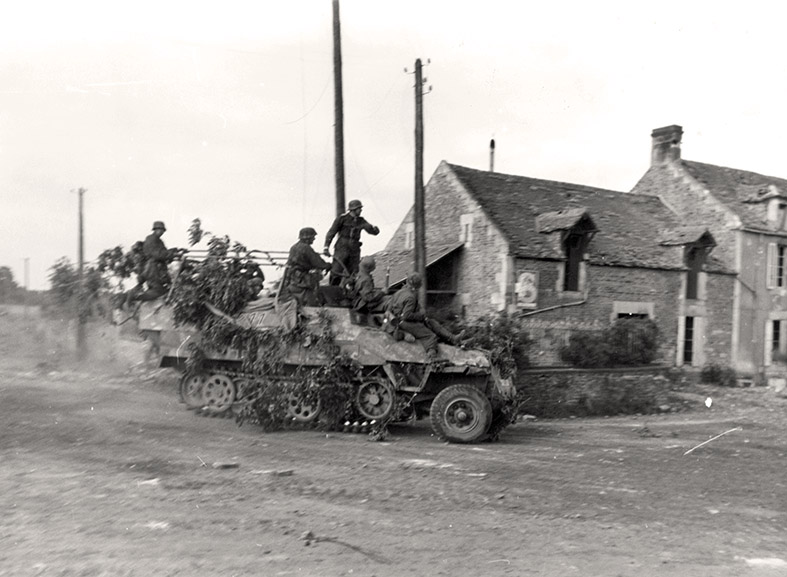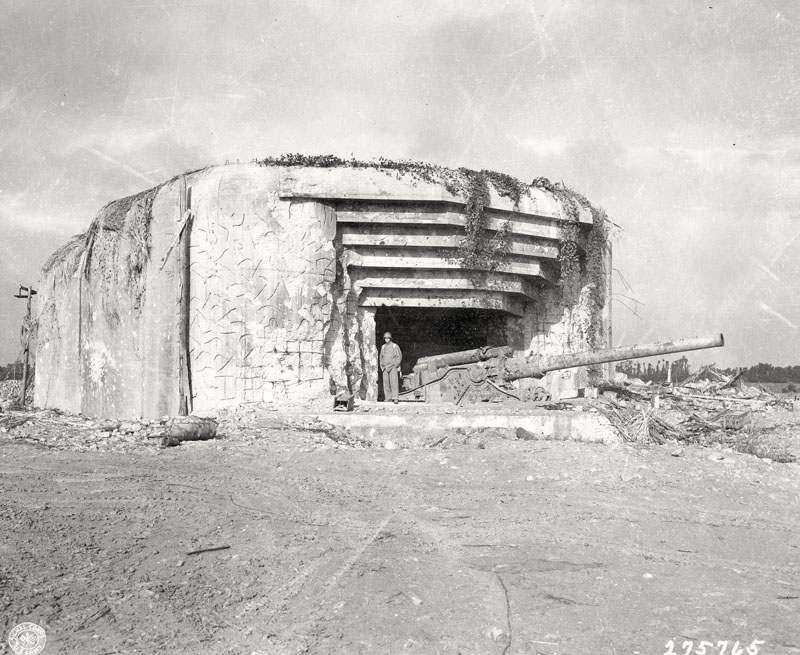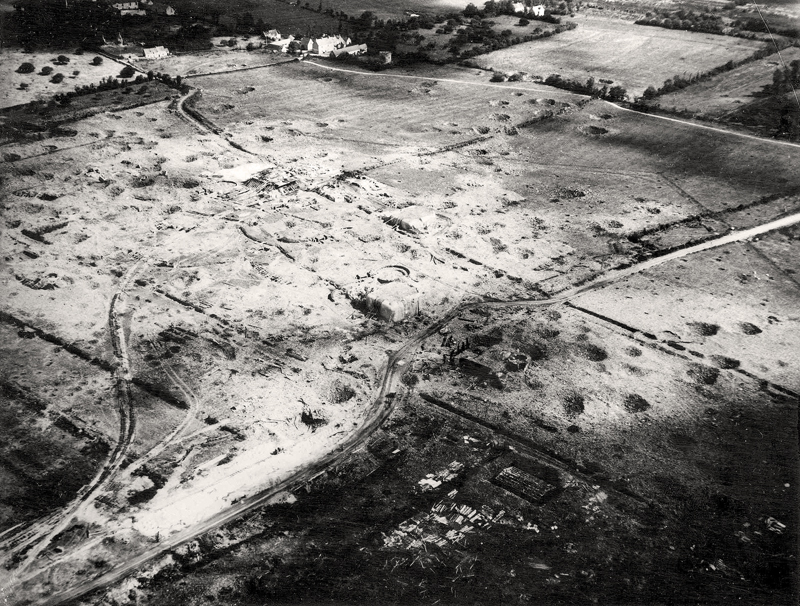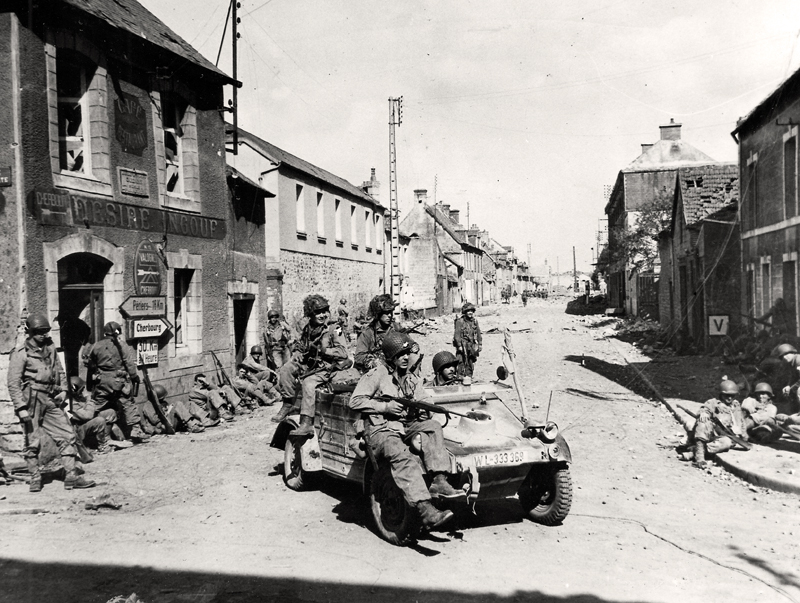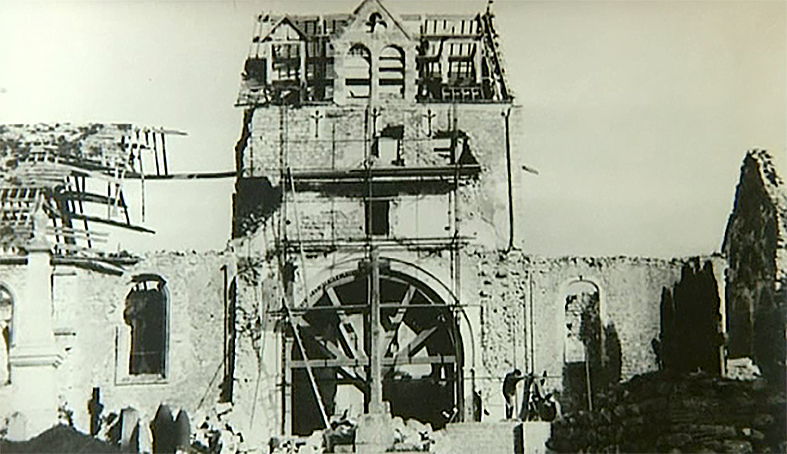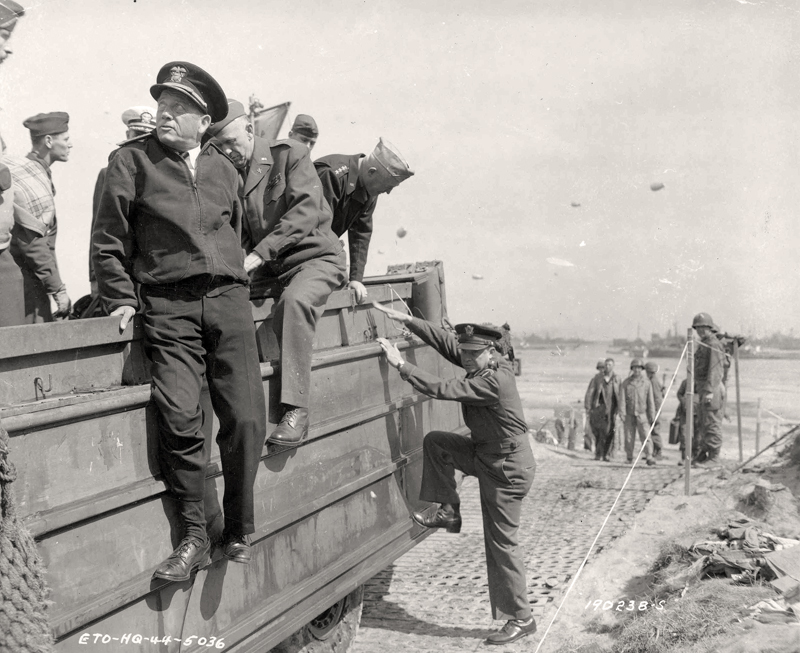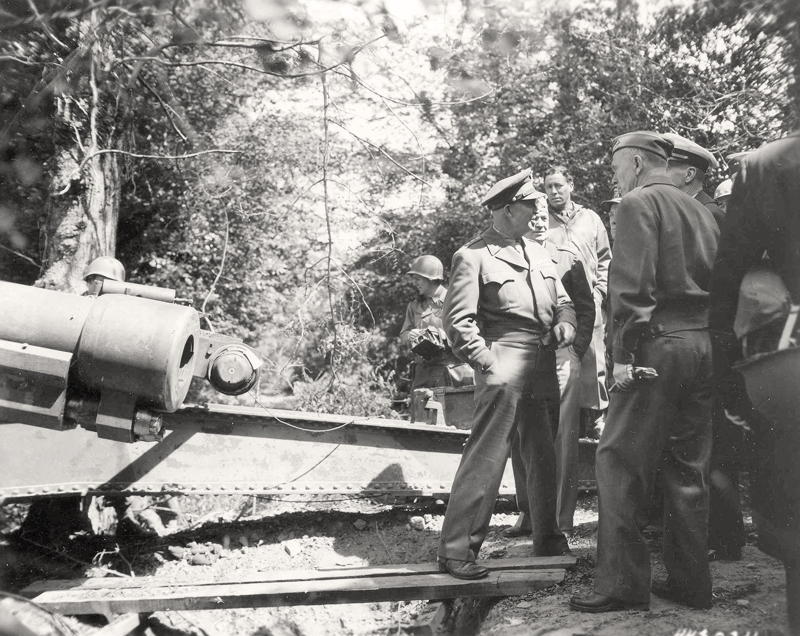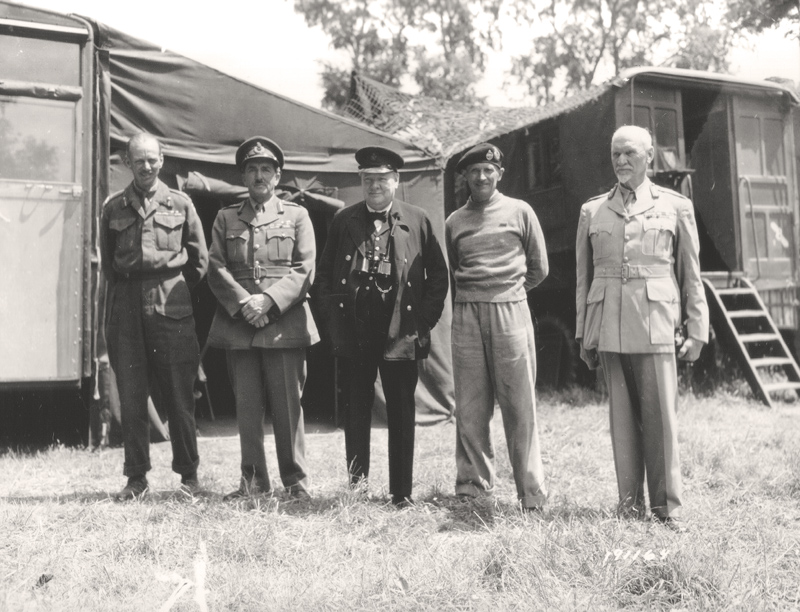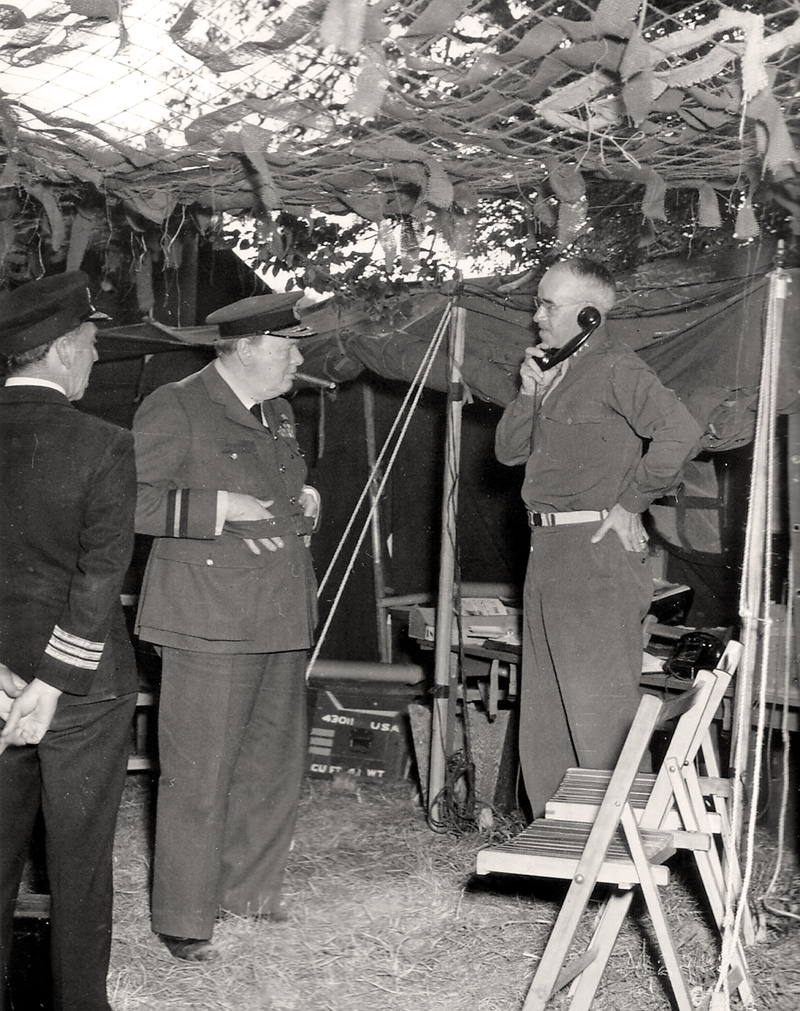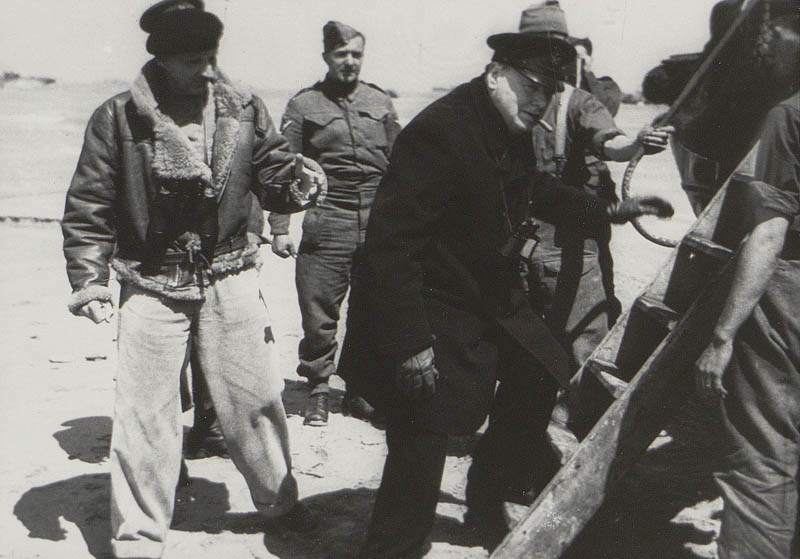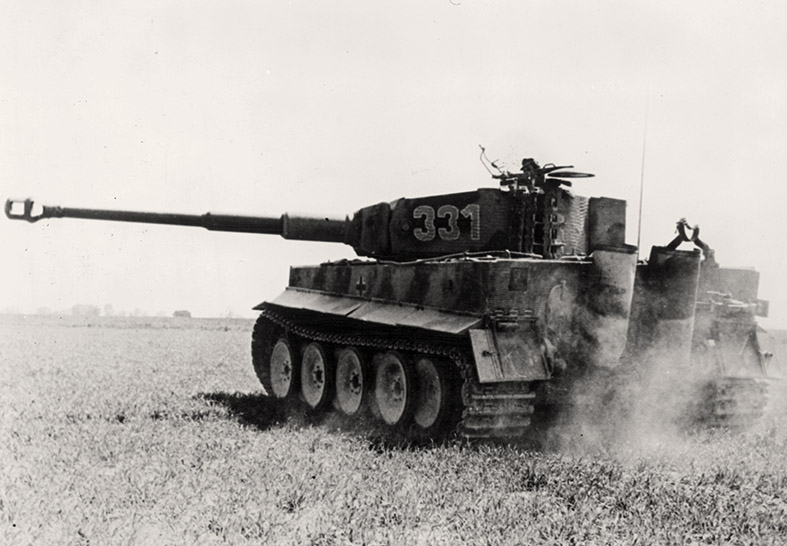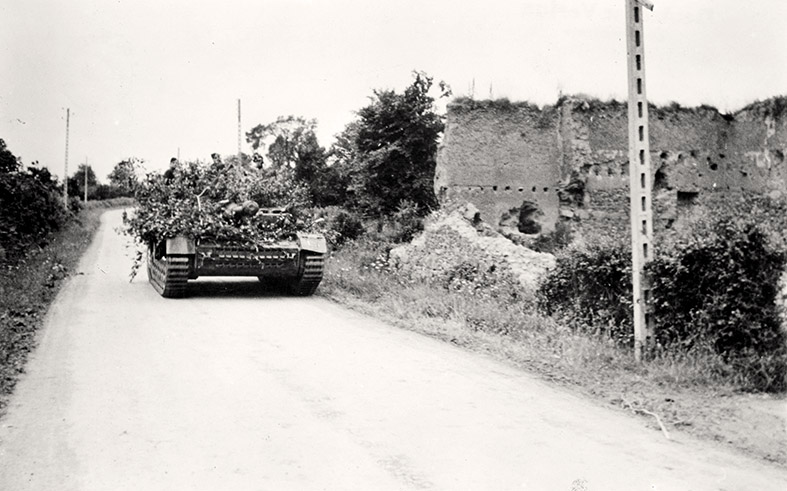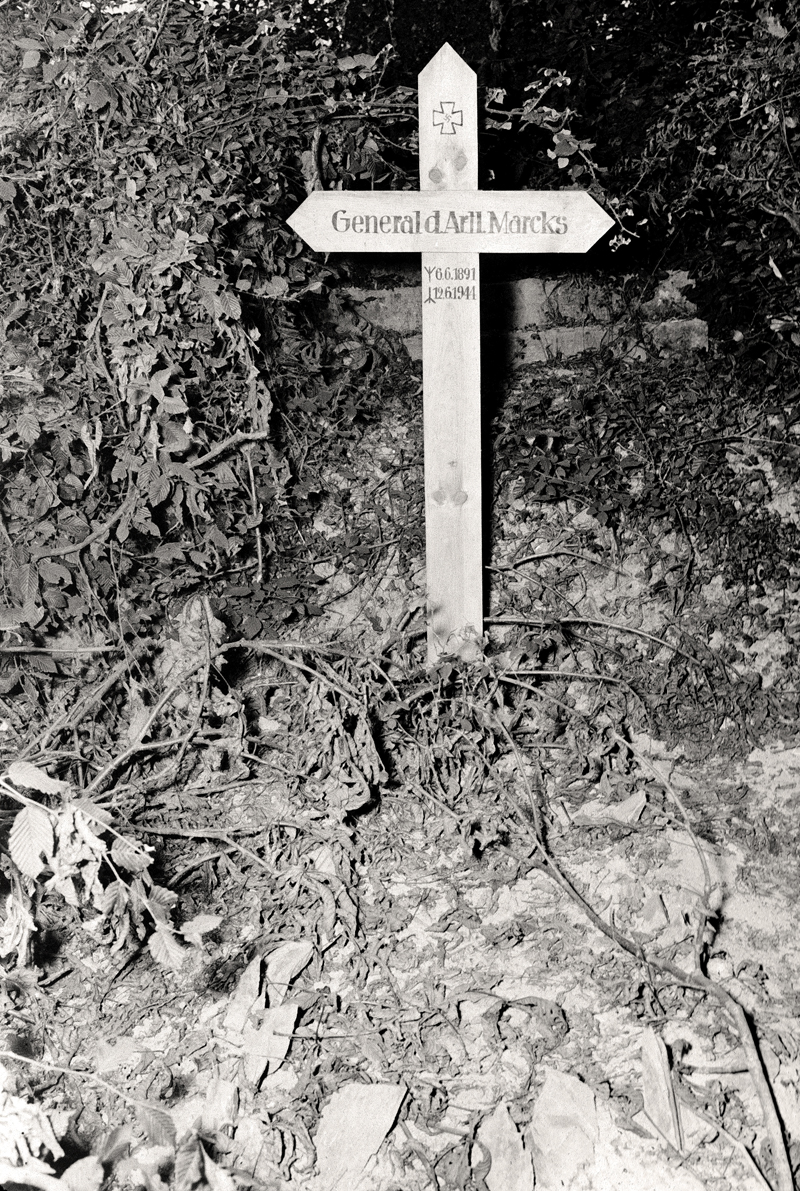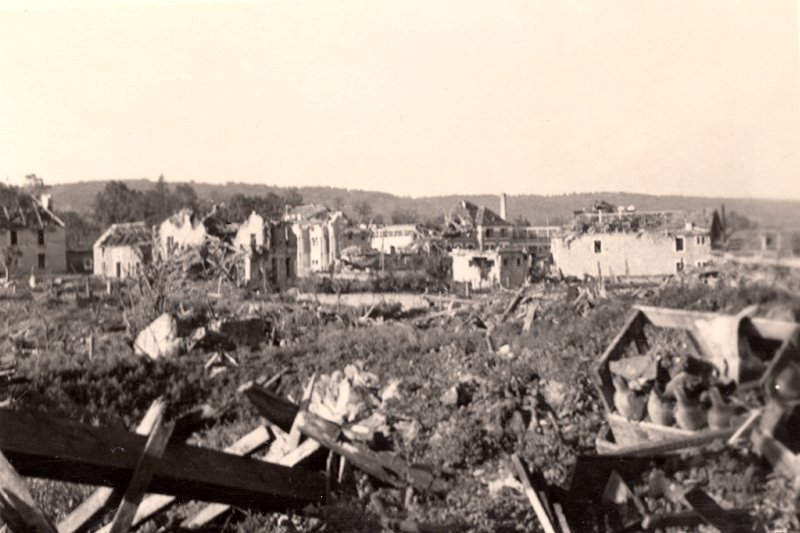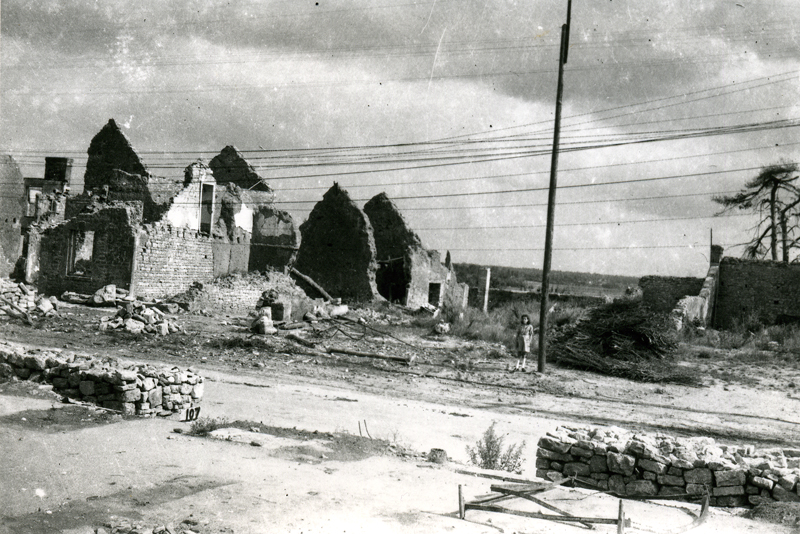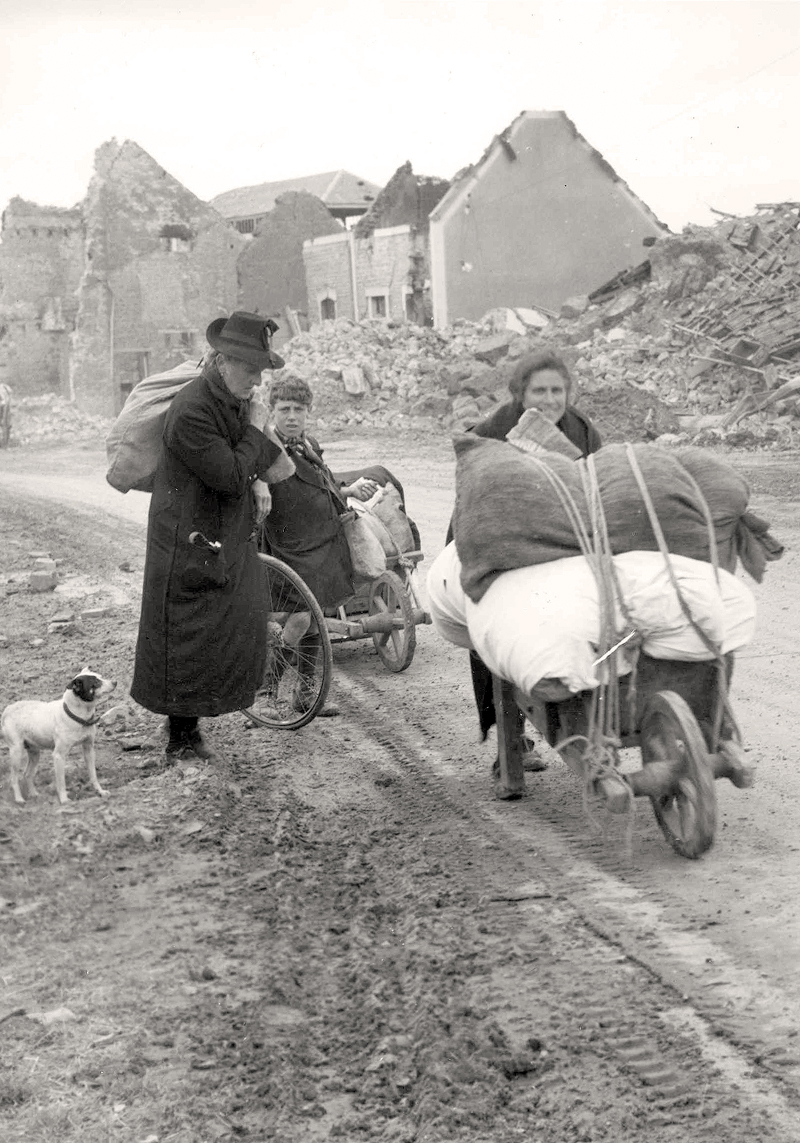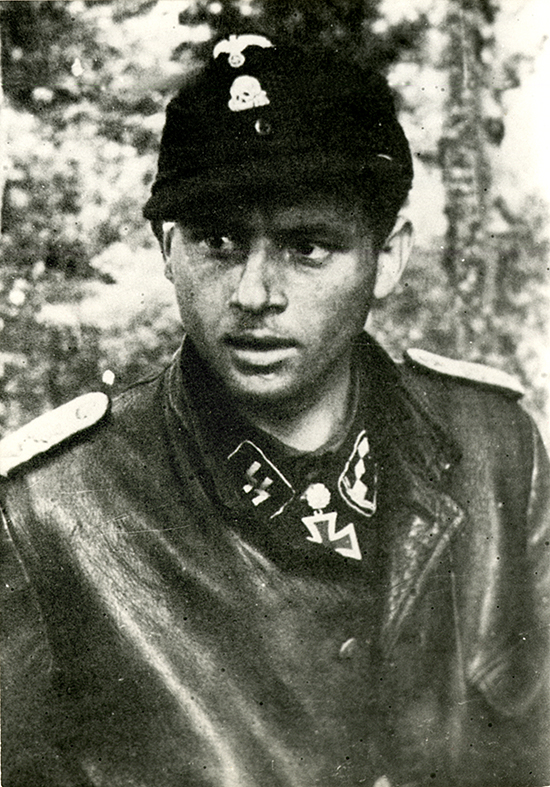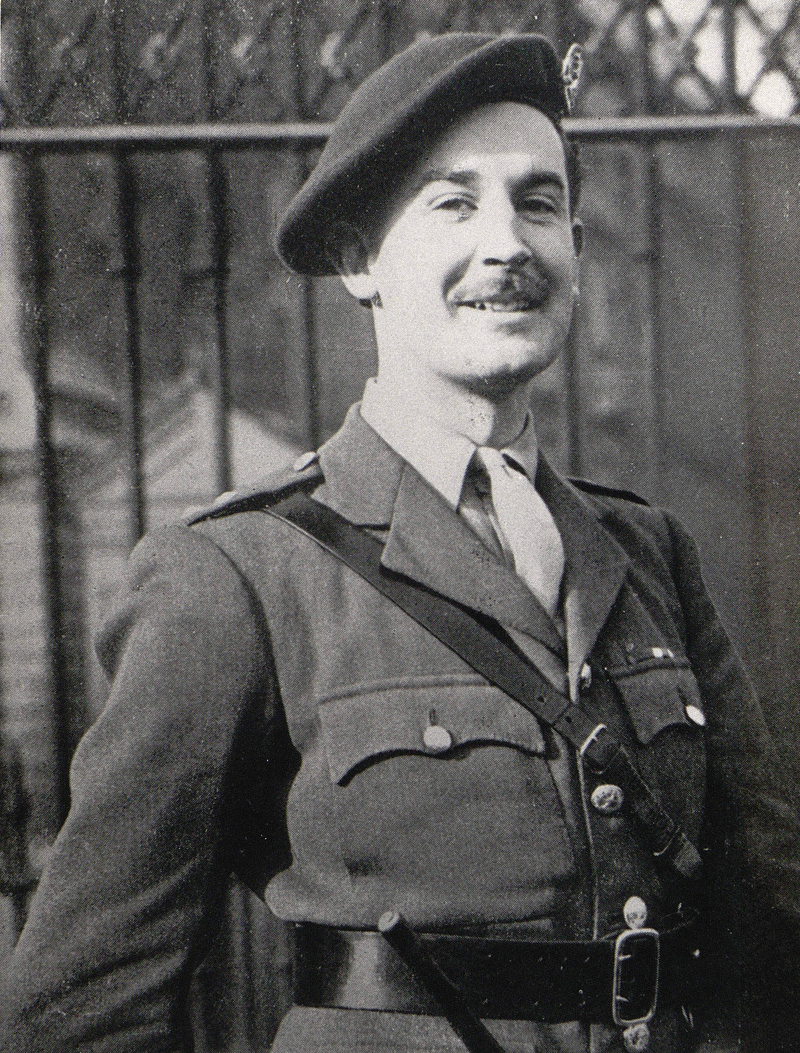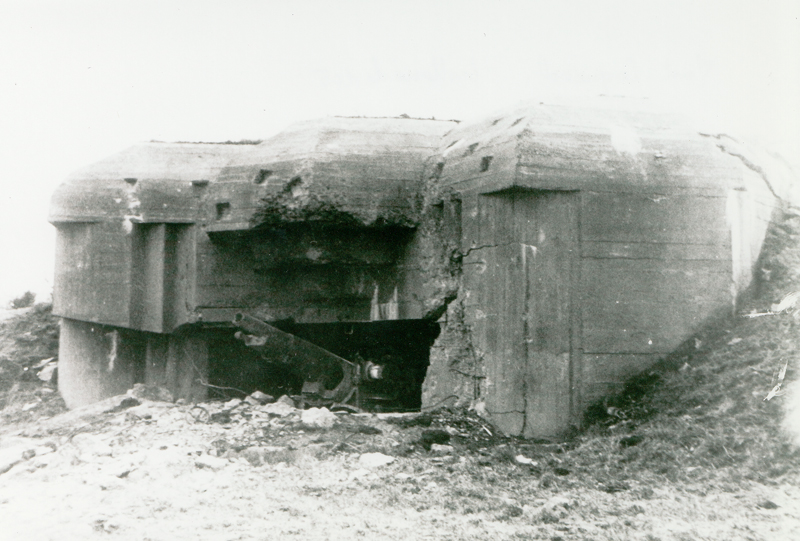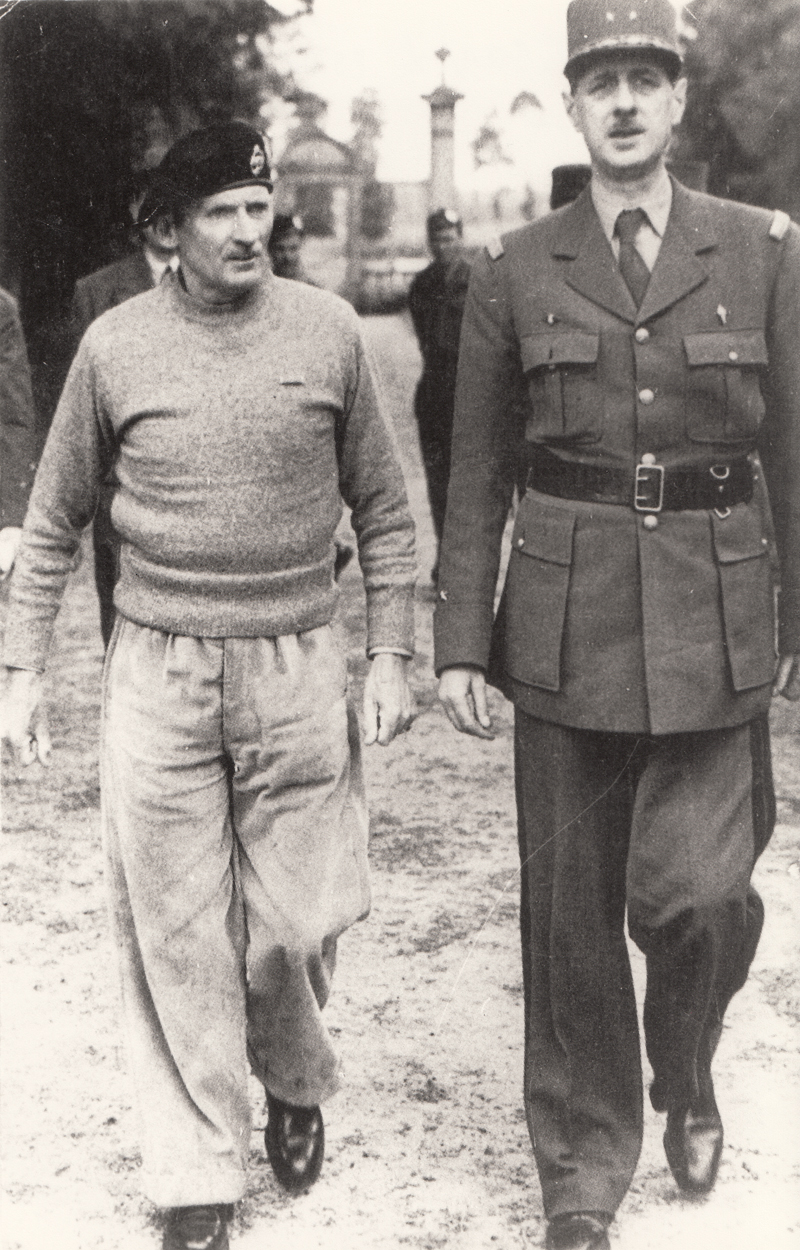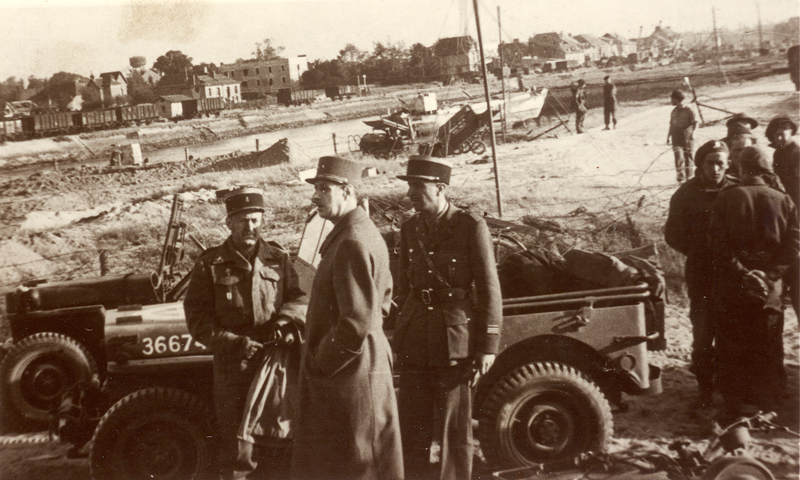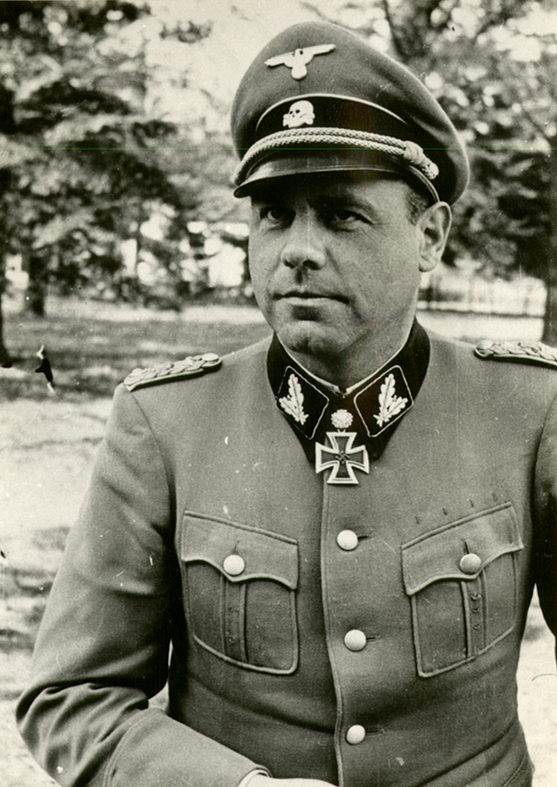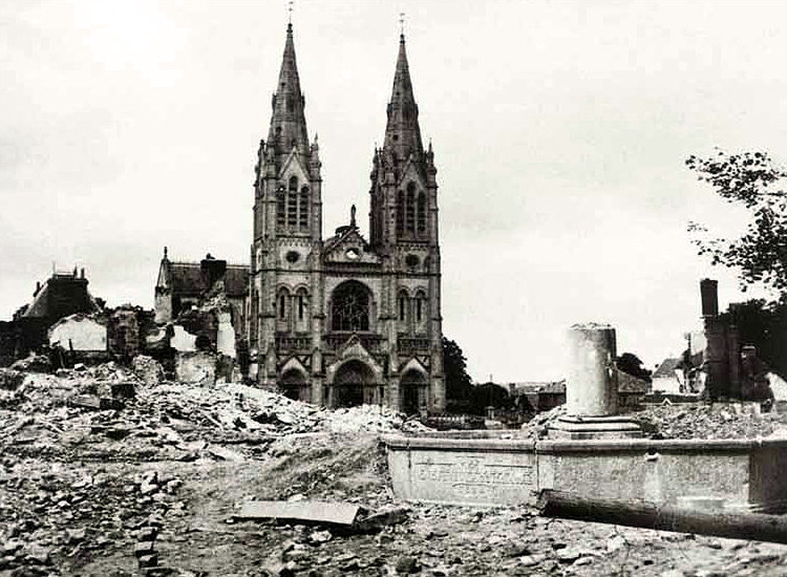7th June
Civilians at the Heart of the Battle
The Repeated Bombardment of Norman Towns
Following an unsuccessful bombing campaign on 6th June, several Norman towns, once again, became the target of the Royal Air Force. Vire, Condé-sur-Noireau, Lisieux, Argentan, Saint-Lô and Coutances were pounded by Allied bombs.
Towards 0100 hours, another raid hit Condé killing 200 inhabitants, including the mayor and destroying 70% of the town. Thirty minutes later, Lisieux was also bombed, the centre of the town was obliterated but, miraculously, as the inhabitants had taken shelter in the building, the Basilique Sainte-Therese remained untouched. However, 700 people lost their lives in Lisieux that day.
Between 0230 hours and 0300 hours, a new bombing raid was carried out on Caen, the Charité and Miséricorde districts and the Fire Brigade headquarters were badly damaged. The lycée Malherbe took in 7,000 refugees and 1,500 people took shelter in the Abbaye de Saint-Etienne.
The Bon Sauveur hospital was transformed into a shelter for 2,000 people including 1,500 wounded. The bridges over the River Orne were finally destroyed in this raid but, 200 additional victims were pulled from the ruins. In Coutances, 312 civilians were killed and in Saint-Lô, 352 lost their lives.
By dawn on 7th June, the civilian losses were heavy, more than 3,000 had been killed, losses as high as those sustained by the Allied troops on the beaches on 6th June.
In the afternoon more air raids were carried out by Flying Fortress bombers on Flers, Condé-sur-Noreau, Lisieux, Argentan, Falaise, Avranches, L’Aigle and Valognes. The perimetres of Alençon, Fougeres, Mayenne and Rennes were also bombed to prevent German reinforcements arriving from these regions.
A Sanitary Cordon at the Lycée Malherbe in Caen
From the first bombing raids on 6th June, the refugees from the city of Caen headed to the various locations which had been set up, in the months before the landings, by the Défense Passive, the emergency services. The majority of the refugees gathered at the Bon Sauveur hospital and Centre N° 4 at the lycée Malherbe installed in the old monastic buildings of the Abbaye-aux-Hommes and of the Abbaye Saint-Etienne adjoining it. On all the levels of the lycée, from the cellars to the attics, in the cloisters and the nave and the apses, everywhere, thousands of inhabitants of Caen took refuge. On 7th June, the lycée’s refectory was transformed into a hospital and some of the municipal services were transferred to the classrooms of the lycée, a nursery and baby feeding facilities were also established. Twice a day, hot meals were served to the refugees, this service continued to function until 15th July. From 7th June, day after day, the lycée Malherbe became a town within a town housing half of the 20,000 inhabitants who had chosen not to leave the city, despite the sufferance and drama.
The American Sectors
- Omaha Beach -
Extending the Bridgehead
From 0300 hours the USS Baldwin shelled the coast at Formigny, Trevières and Etreham. During the day, the RN13 roadway was also shelled by the Texas, Arkansas, Glasgow, Georges Leygues and the Montcalm. The objective was to push the Germans back enabling the Allies to extend their bridgehead. Saint-Pierre-du-Mont was reached by 1100 hours before a German counter-attack forced the American units to withdraw. Saint-Laurent-sur-Mer was liberated by 3rd Battalion of 115th Regiment at 0900 hours with the help of gunfire from the USS Priest. In the evening, Formigny was assaulted by 26th Regiment of 1st American Infantry Division. Meanwhile, reconnaissance patrols sent along the RN13 highway indicated that Tour-en-Bessin was firmly held by the Germans.
The Liberation of Colleville and Vierville
The village of Colleville-sur-Mer had been reached the previous day by men of 16th Infantry Regiment. However, due to stiff resistance from 352nd German Division, the GIs were unable to liberate the village. It was only towards 1000 hours that Colleville-sur-Mer finally fell to men of 1st Infantry Division and an armoured force, while the village of Huppain was liberated later in the evening.
Vierville was liberated towards 1100 hours by troops of 116th Infantry Regiment but the Germans counter-attacked on 7th June at 0530 hours. At midday, Vierville, after having changed hands several times, was finally liberated by the American forces.
The Fate of the Rangers
Initially conferred on “B” Force, which consisted of C Company of 2nd Battalion, the assault on the guns at la Pointe de la Percée could not go ahead at dawn on 6th June. However, the survivors of B Company, who had landed on Dog Green sector of Omaha Beach managed, later in the day, to capture the two Skoda field guns of 76mm calibre which were capable of firing along the flank of the entire beach.
Isolated and short of ammunition at la Pointe du Hoc, Colonel Rudder and his men called for reinforcements and eventually, on the afternoon of 6th June, 30 surviving men of A Company of 5th Ranger Battalion, who had landed on Omaha Beach, arrived by sea with ammunition. On the morning of 7th June, reinforcements, composed of 500 men of 1st Battalion of 116th Infantry Regiment and 5th Rangers, set out towards la Pointe du Hoc. The force reached la Pointe at 1200 hours the following day, relieving the 90 men and forcing the Germans to withdraw towards Grandcamp.
The Artificial Port at Saint-Laurent-sur-Mer
The two artificial ports constructed for Operation Overlord off the Norman Coast, shortly after the landings, were a major innovation and a stroke of genius on the part of the British.
On the morning of 7th June, the first elements of the artificial harbour, codenamed Mulberry “A”, were installed off the coast at Saint-Laurent-sur-Mer. The principal structures of the port were the Phoenix caissons which were constructed of concrete and weighed between 1,500 and 7,000 tons and were designed to form a solid breakwater against the sea.
The installation of the breakwater composed of the concrete blocks and old ships, was due to take no longer than three weeks. Following its completion, jetties and platforms would be installed allowing men and equipment to be unloaded. A second artificial port, Mulberry “B” was installed, in the same manner, at Arromanches-les-Bains.
The First Airfield at Omaha Beach
In order to give constant air cover for Operation Overlord, the Allies, by 7th June, had started the construction of airfields in Normandy. The first airstrip was American and was laid out by 834th Engineer Aviation Battalion on the Laurent-sur-Mer plateau, high above Omaha Beach. The first elements of the A21 emergency airstrip were installed, on 7th June, and it was in use by 1800 hours but, it wasn’t before 10th June that the airfield was fully operational and continued so until its closure on 25th August 1944. Two other emergency air strips were installed simultaneously at Asnelles (British airfield B1) and at Brucheville (American airfield A-16). In total, 81 airfields were constructed in Normandy, some in the American sector under the command of US 9th Air Force and others in the Anglo-Canadian sector of 2nd Tactical Air Force.
Additional Reinforcements at Omaha
As planned by the Allied strategic planners, an incessant flow of reinforcements arrived on Omaha. In the afternoon, 9th Infantry Regiment, the first elements of General Robertson’s 2nd Infantry Division (the Indian Head Division), set foot on Omaha Beach. The regiment’s mission was to extend the bridgehead by clearing the remaining German pockets of resistance around the beach. Following on, were the first units of 2nd Armoured Division, commanded by General Brooks, which was composed of 15,000 men and 400 tanks, half of which were Shermans. The “Hell on Wheels” division was the first armoured division to land on the Continent.
- Utah Beach -
Clearing the German Pockets of Resistance
The junction between the parachutists and the forces which had landed on Utah Beach was established at Sainte-Mère-Eglise when 505th Parachute Regiment of 82nd Airborne met up with 8th Infantry Regiment of 4th Infantry Division. Towards 1500 hours, General Collins, commander of 7th US Corps, entered Sainte-Mère-Eglise and met General Ridgeway at his headquarters which had been established to the west of the town.
The parachutists were desperately trying to enlarge the bridgehead which had been formed the previous day. In the evening, a front running from Neuville-au-Plain to Chef-du-Pont passing via the bridge at La Fière was held by 82nd Airborne which had been reinforced, in the meantime, by elements of 325th Glider Infantry Regiment and 8th Infantry Regiment.
On 101st Airborne front, the division continued its attacks on Saint-Côme-du-Mont and Houseville but, without success due to the strong defense put up by the German parachutists. However, Turqueville was taken by 8th Regiment after the surrounded Georgians of 795th Battalion surrendered. The 90th American Infantry Division, which had recently landed, temporarily set up its headquarters in the village.
In order to open up the road to Cherbourg, the Americans had to seize the batteries at Azeville and Crisbecq-Saint-Marcouf, to the north of Sainte-Mère-Eglise.
The 22nd Regiment Assaults the Crisbecq and Azeville Batteries
Situated on high ground, three kilometres from the sea, was the Crisbecq naval gun battery, with its four 210 mms guns and a garrison of 400 men. With the exceptions of the fortresses at Le Havre and Cherbourg, the battery was the most powerful along the coast of the Baie de Seine. Despite having been damaged on 6th June, the battery remained a threat on 7th June with its guns intact and directed towards Utah Beach. In the morning, men of 22nd Regiment of 4th Infantry Division attacked the position but, had to withdraw due to the heavy losses it had sustained. Another unsuccessful attack began on 8th June, with heavy artillery support, and continued until 9th June when the Americans subsequently moved on towards Quinéville and Montebourg in order to keep their losses to a minimum. The Crisbecq Battery finally fell on 12th June 1944 after it had been evacuated the previous night by the German Forces.
The 22nd Regiment also assaulted the Azeville Battery which was composed of 4 guns of 105 mm calibre and with a garrison of 170 men. However, 2nd Battalion was pushed back to its original start line by a German counter-attack. Captain Treiber’s garrison finally surrendered on 9th June 1944 following an attack by flame throwers and an intense naval bombardment.
The Combat at the La Fière Bridge
For the parachutists of 82nd Airborne, the fighting at La Fière Bridge began on 6th June and doubled in intensity on 7th June and continued until 9th June. It was vital to hold the bridge and the raised causeway crossing the valley, which had been flooded by the River Merderet, in order to prevent the German forces advancing on Sainte-Mère-Eglise. The troops also had to take a foothold on the far bank to make the junction with the airborne troops who had been dropped further west well behind the enemy lines. On 7th June, following a heavy artillery barrage, the Germans recommenced their assault but, 1st Battalion of 505th Regiment resisted and held the bridge. The combat at La Fière continued for a further two days and only finally ended on 9th June when General Gavin, deputy commander of 82nd Division, led troops of 507th Regiment and 325th Glider Infantry Regiment in seizing the village of Cauquigny, which led on to the Causeway at La Fière but, with heavy losses on both sides.
The British Sectors
- Gold Beach -
Securing and extending the Bridgehead
The British forces, after having made the junction with the Canadians at Juno Beach on their left flank, continued their advance to the south. Port-en-Bessin, which was still in German hands, had to be liberated rapidly, along with the ports of Grandcamp, Isigny and Courseulles as they were vital to the Allied logistical effort before the artificial harbours became operational. Troops of 47 Royal Marine Commando set out in the early hours, eventually liberating the fishing village and capturing 300 prisoners. Along the coast, 184 men of the Longues-sur-Mer Battery, which had been badly damaged by naval gun fire, surrendered to the British forces arriving from inland.
Following the liberation of Bayeux on the RN13 highway, the British controlled a strategic axe of communication enabling the Allies to stabilise the front from Caen to the Cotentin.
Bayeux First Town Liberated on the Continent
British forces liberated Bayeux, without any German resistance, on the morning of 7th June. From the previous day, units of 56th and 151st Brigades had taken up positions on the outskirts of the town after having landed on Gold Beach. Saint-Vigor, in the suburbs of the town, had even been occupied by 2nd Gloucestershire Regiment on 6th June. On the morning of 7th June, troops of 2nd Essex Regiment of 56th Brigade (50th Division) were the first to enter the town following several short skirmishes near the Post Office, which attracted the applause of a curious crowd of onlookers. During the afternoon, Bayeux finally celebrated its liberation, the German forces had evacuated the town preferring to concentrate on defending Caen. Bayeux, the sub prefecture of the Calvados district that had been saved from Allied bombing became the first town to be liberated on the Continent.
The Artificial Port of Arromanches
Elements of the port were prefabricated in England, towed across the Channel and installed off the coast at Arromanches to form a second artificial harbor, similar to the port at Saint-Laurent-sur-Mer. It was the beginning of the installation of Mulberry “B” also named “Port Winston” after British Prime Minister, Winston Churchill, who had the idea of constructing the harbours. In addition to the caissons, 17 block ships were sunk to reinforce the concrete structures. Mulberry “A”, at Saint-Laurent was reserved for the American forces and Mulberry “B” for the British. This division existed until the devastating storm of 19th-22nd June which completely destroyed the American port leaving Arromanches as the only Allied artificial harbor operational during the Battle of Normandy.
The BBC in Normandy
The village of Creully, situated on the boundary of the Gold and Sword Beach sectors, was liberated by tanks of 4th/7th Dragoon Guards. The following day, technicians of the BBC (British Broadcasting Corporation) installed, in the tower of the town’s castle, a broadcasting studio which was made available to all journalists covering the Battle of Normandy. On 19th June, the first direct broadcast was transmitted on British Radio. In this small town, situated several kilometres from the front line and dominated by the tower of the castle which had been occupied by the British in 1417 during the Hundred Years War, American, Canadian and French BBC War Correspondents broadcast not just to the Home Service and the armies but also to places as far afield as Africa and even the Pacific.
The “Scots” Land
Advanced elements of the 51st Highland Division landed on the evening of 6th June but, the main force disembarked at 0800 hours on 7th June. The 51st Highland Division was a territorial division with most of its complement of troops being captured in France in 1940. It was subsequently reformed and participated in the North African Campaign in June 1942 and Sicily in July 1943. The division’s highly experienced troops were repatriated to Great Britain in November 1943 in order to prepare for Operation Overlord. Immediately after landing, the “Scots” took up position to the east of the River Orne to reinforce 6th Airborne and the fragile bridgehead, making contact with the enemy for the first time, at the Douvres-la-Délivrande radar station while on its way. On 9th June, the division was again in combat against the German forces in the Bois de Bavent.
- Sword Beach -
The British Objectives
The two commando brigades that had landed on Sword Beach had a dual role: to consolidate the airborne bridgehead alongside 6th Airborne to the east of the Orne against attacks by 21st Panzer and to liberate the various towns along the coast where the Germans were still resisting in their strong points at Lion-sur-Mer, Luc-sur-Mer and Langrune-sur-Mer. Meanwhile, the infantry of General Rennie’s 3rd Division, that had taken the beach but, had not consolidated the bridgehead, advanced towards Caen. In order to achieve its objectives, Rennie’s troops had to break the lines of German resistance deeply entrenched at Cambes-en-Plaine, Lébisey and Blainville.
The Commandos Assault Bréville and Merville
The troops of N°3 Commando (1st Special Service Brigade) advanced along the Salenelles/Ranville road and occupied the area to the south-west of Amfreville in order to prevent any infiltration by the enemy. At Merville, the force attempted to complete the previous day’s mission by Colonel Otway’s 9th Parachute Battalion before being repulsed by a combat group of 736th German Grenadier Regiment which seized the battery. While N° 4 Commando and the troops of the Commando Kieffer consolidated their position on the heights at Amfreville, N° 6 Commando (1st Special Service Brigade) distinguished itself in the only offensive action of the day: destroying four artillery guns and two anti-aircraft guns near the village of Bréville-les-Monts without actually taking the village which was heavily defended by the Germans. Bréville continued to form a salient menacing directly Ranville at the centre of the airborne sector.
The Royal Marine Commandos
After heavy fighting, Lion-sur-Mer was liberated in the evening by 41 Royal Marine Commando (4th Special Service Brigade) that had landed at the western extremity of Hermanville and had assaulted the German strong point, code named “Trout” (two anti-tank guns, mortars and machine guns) with naval gun fire support. Lieutenant Colonel Hardy’s 46 Royal Marine Commando (4th Brigade), which initially would have landed at Houlgate and Bénerville, finally disembarked at 0600 hours, on 7th June, at Saint-Aubin-sur-Mer to attack the Petit-enfer strong point. The fortified position fell at 1800 hours along with 65 prisoners of 716th German Division. Further on, Luc-sur-Mer was liberated by 41 Royal Marine Commando shortly before 2200 hours after having made the junction with 46 RMC.
The 3rd British Divisional Front
In the morning, 3rd Infantry Division and its 185th Brigade advancing towards Caen came up against heavy resistance, from 21st Panzer, in the Lébisey Wood. Cresserons fell to 1st South Lancashire (8th Infantry Brigade) advancing from Hermanville-sur-Mer after the grenadiers of 21st Panzer made a fighting withdrawal. The village of Mathieu was attacked by the Kings Own Scottish Borderers (9th Infantry Brigade) and, at 1700 hours, 2nd Royal Ulster Rifles (9th Brigade) attempted to seize Cambes-en-Plaine which was defended by grenadiers of the SS division. The British advanced no further south, blocked by the men and armour of 21st Panzer.
The British Paras in Action
Ranville and the Bas-de-Ranville were occupied by 12th and 13th Parachute Battalions. While, 2nd Battalion Ox and Bucks of 6th British Airborne took Hérouvillette before the advance stalled at Escoville. Sainte-Honorine-la-Chardonnette was assaulted, at midday, by 1st Royal Ulster Rifles (the Irish battalion of 6th Air landing Brigade). Solid resistance by Major von Luck’s 125th Panzer Grenadier Regiment forced the Irish to withdrew, leaving 60 of their comrades behind the German lines. The following day, only 20 were able to rejoin their battalion. General Gale’s men, nevertheless, held the crest and the access to the plain. The outcome of the days combat was, however, in the Germans favour as they had been able to launch offensives against Ranville and Longueval and regrouped, not only, at Sannerville and Troarn but, also to the east of Caen at Banneville-la Campagne, Cuverville and Touffreville.
The Canadian Sector
The Advance of 7th Brigade
The Canadian 7th Infantry Brigade (Regina Rifles Regiment, Royal Winnipeg Rifles) advanced towards its objectives on the evening of 6th June. The brigades advance was completely clear of any German opposition. In the morning, Secqueville, Putot-en-Bessin, Norrey-en-Bessin and Bretteville-l’Orgueilleuse where liberated one after the other. Foster’s Brigade was certainly the Allied force which had advanced the furthest inland. By day’s end, its progression had enabled it to reach the Caen-Paris railway line with the Royal Winnipeg Rifles occupying Putot-en-Bessin.
The Failure of 9th Brigade at Authie, Buron, Saint-Contest
The objective of the Canadian 9th Brigade was to advance, with naval gun fire support, on Buron, Authie, Franqueville and Carpiquet. Towards 1100 hours, troops of the North Nova Scotia Highlanders and tanks of 27th Regiment crossed, without difficulty, the anti-tank ditch at Buron, north of Caen, and made their way through the village at 1150 hours. Authie was reached, also without difficulty, at 1230 hours. However, with Carpiquet in sight, artillery fire from 25th SS Panzer Grenadier Regiment (12th SS Hitler Youth Division) rained down on the Canadian-Scots. A and B Companies were decimated as they withdrew to Buron and C Company was annihilated in Authie by grenadiers of 25th Regiment. A withdrawal was ordered to Villons under the protection of Royal Navy gun fire. The Germans had destroyed 21 Canadian tanks and 400 men were lost, 110 of them killed in action. Authie, Buron and Saint-Contest were still in German hands.
The Liberation of Saint-Aubin, Graye-sur-Mer, Langrune-sur-Mer and Douvres-la-Délivrande
Saint-Aubin was liberated by troops of the North Shore Regiment (8th Canadian Brigade) overcoming resistance from German troops of 736th Infantry Regiment. Graye-sur-Mer was conquered by the Royal Winnipeg Rifles (7th Canadian Brigade) after assaulting a strong point at a sanatorium, to the west of the town, which was very heavily defended by German gunners. At 2200 hours, two Troops of 46 Royal Marine Commando, advancing from the Petit-enfer strong point through Luc-sur-Mer and Saint-Aubin-sur-Mer, entered Douvres-la-Délivrande, without any resistance from the Germans who had been liberally shelled by naval gunfire the previous day.
At Langrune-sur-Mer, the combat, which had begun on 6th June, doubled in intensity between 1130 hours and 1530 hours as 48 Royal Marine Commando attacked a German strong point. Langrune was finally liberated by Lieutenant Colonel Moulton’s troops but, by the end of the battle, Moulton had lost half of the men who had landed the previous day to the east of Saint-Aubin.
The German Forces
Kurt Meyer at the Abbaye d’Ardenne
Kurt Meyer, commander of 25th Regiment of 12th SS Panzer Division, took up position at the gates of Caen in the Abbaye d’Ardenne. Meyer had installed his HQ here as the towers of the abbey offered a magnificent view of the plain towards the sea and the Allied troop movements. Meyer had been ordered by his superior, General Fritz Witt, to push the British into the sea. Meyer’s 1st Battalion established itself around Epron while his 2nd Battalion was situated at Saint-Contest and his 3rd was positioned to protect the RN13 highway. Meyer was a veteran of 34 years of age with solid combat experience in Poland, France, Yugoslavia, and Greece prior to joining 12th SS Hitler Youth Division. In moving his forces towards Caen and rapidly resisting the Canadians, Kurt Meyer, who took command of the division on 14th June, blocked the Allied access to Caen for more than a month.
Reinforcements for Normandy: the Führer Gives the Green Light
In the early hours, von Rundstedt received an order from the High Command in Berlin to deploy reinforcements from Brittany and south of the River Loire. From its encampment at Thouars (Deux–Sevres), 17th SS Goetz von Berlichingen Grenadier Division headed in the direction of Saint-Lô, while General Stegmann’s 77th Infantry Division left Saint-Malo for the front in Normandy. The first railway convoy of units of 275th German Division left the southern Morbihan district and headed to Rennes. However, due to sabotage on the line, the nine convoys were unable to progress immediately and it was only at 1900 hours that the first convoy left Redon. The Panzer Lehr Division, which had left Chartres the previous day, carried out its first attack in Normandy at 0530 hours, along the Vire to Bény-Bocage highway near Falaise.
The losses, however, were high for a division not yet completely engaged on the Norman front.
Emergency Meeting at General Richter’s Headquarters
In General Richter’s underground headquarters, north of Caen, a new conference was held by the German generals in preparation for a counter-attack at Caen. Field Marshal Rommel also attended after having travelled from his headquarters at La Roche-Guyon. Richter’s 716th Infantry Division had lost 3,000 men in the Gold, Juno and Sword sectors while General Kraiss’ 352nd Division had losses of 1,200 men in the combat at Omaha. In such conditions, it was difficult for the German command to prevent an enlargement of the Allied bridgehead. The generals were pinning their hopes on the reinforcements of the redoubtable 12th SS Division which had set out from the Bernay-Lisieux-Vimoutiers region in order to push the British into the sea north of Caen. On 7th June, General Witt’s division affronted, with full force, the Canadian advance causing heavy losses amongst its units. Despite being unable to carry out a major counter-attack, the German command had managed to substantially break the Anglo-Canadian advance towards the Norman capital.
3.99-1
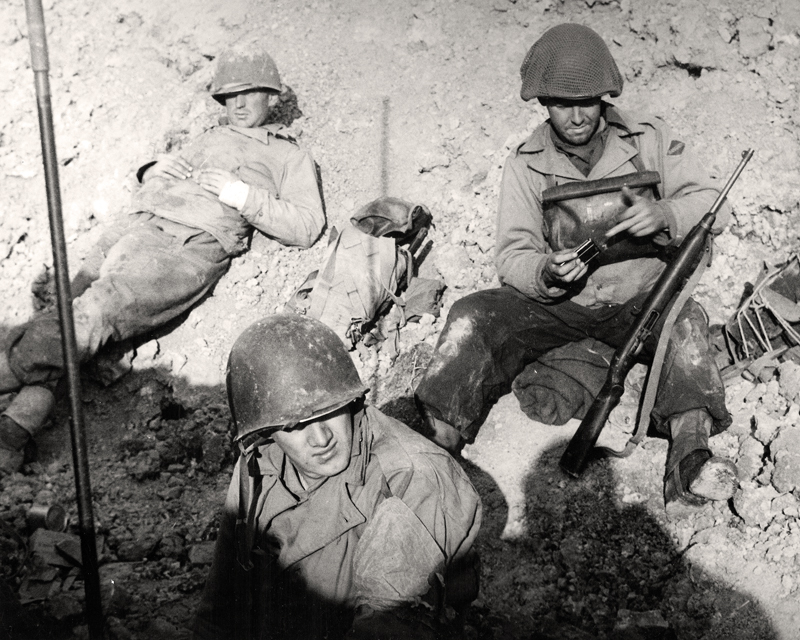
3.99-2
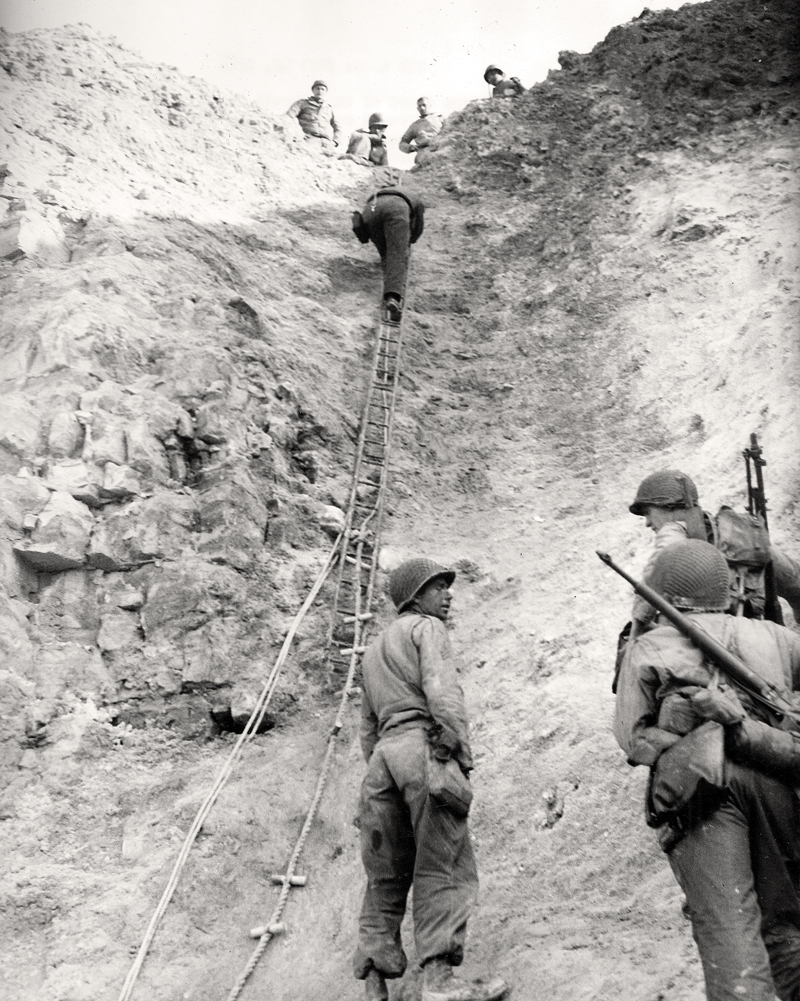
3.99-3
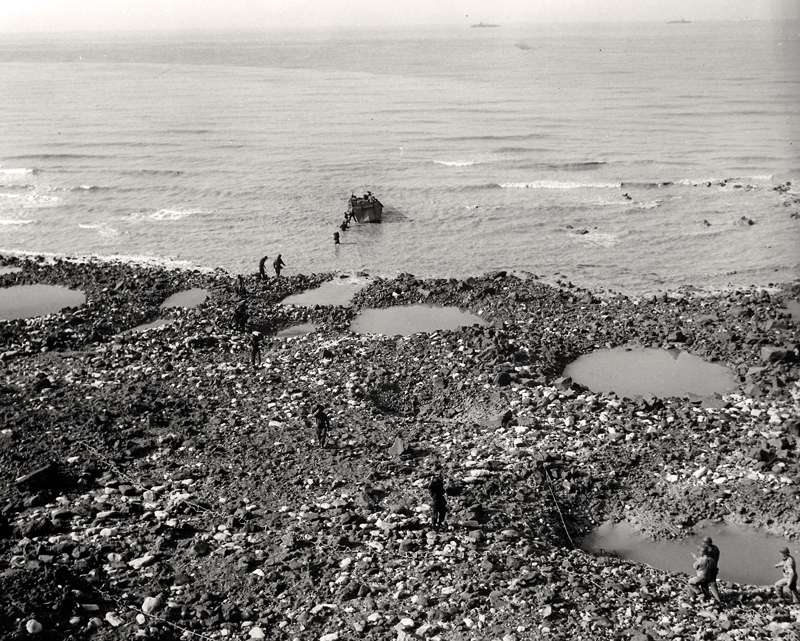
8th June 1944
The American Sectors
- Omaha Beach and Pointe du Hoc -
Cleaning-Up Operations at La Point du Hoc
Since the initial assault on 6th June, the Rangers remained isolated at la Pointe du Hoc receiving no reinforcements. A junction was established, however, between a rescue column blocked at Saint-Pierre-du-Mont (1st Battalion of 116th Infantry Regiment) and a group of Rudder’s Rangers. The final assault on the Pointe was launched later in the morning and by midday, the site was finally cleared of any resistance following the assault by 1st and 3rd Battalions of 116th Infantry Regiment and 5th Rangers, supported by gunfire from the destroyer USS Ellyson. Of a total force of 225 Rangers on 6th June, only 90 were fit for combat. The German forces had withdrawn to the west in the direction of Grandcamp-les-Bains.
The Liberation of Grandcamp
To the west of la Pointe du Hoc, Grandcamp was awaiting its liberation.
After reinforcing their comrades at la Pointe, the troops of 116th Regiment of 29th American Division, supported by 5th Rangers and armour from 743rd Tank Battalion, advanced along the coastal road to Grandcamp which was heavily defended by 352nd German Infantry Division. The infantry requested naval gunfire support and the battleship USS Texas and the cruiser HMS Glasgow shelled the German positions around the small port. Over 113 shells rained down on the enemy strong points between 1500 hours and 1600 hours. In the early evening, troops of 116th Infantry Regiment supported by armour of 743rd Battalion, assaulted the town, liberating it later that night. On the evening of 8th June, General Bradley installed his first command post, while work to restore the harbour had begun.
Friendly Fire and 175th Infantry Regiment
On the evening of 7th June, 175th Infantry Regiment (29th Infantry Division) and its supporting armour were ordered to take Isigny. At 0200 hours, 175th Regiment entered Englesqueville before heading south to the RN 13 highway. La Cambe was reached an hour later but, the Americans could advance no further due to anti-tank fire shortly before dawn. A second assault enabled the Americans to liberate La Cambe later that morning. However, tragedy struck 175th Infantry Regiment. An error on the part of the Allied air force led to aircraft firing on La Cambe and 175th Regiment’s front line established between La Cambe and Cardonville. During the attack, six men were killed and 18 gravely wounded.
The Liberation of Tour-en-Bessin and Formigny
In order to widen the fragile bridgehead (3kms in depth), the Americans focused their efforts on Formigny, at the crossroads of the RN13 Highway and the road leading to Saint-Laurent and Vierville-sur-Mer, which controlled the exit from Omaha to Trévières. The advance on 7th June, was halted 800 metres short of the crossroads by stiff German resistance. The 3rd Battalion of 26th Infantry Regiment was relieved by 18th Infantry Regiment which had already succeeded in crossing the highway. Attacking from the south east, 18th Infantry Regiment finally liberated Formigny early on 8th June.
Tour-en-Bessin, situated to the west of Bayeux, was still in German hands two days after D-Day. The 1st Division’s 26th Infantry Regiment was to assault after having crossed the River Aure and a patrol from 2nd Battalion entered the town shortly before midday following a heavy Allied bombardment at 0900 hours. After the liberation of Tour-en-Bessin and a subsequent Allied advance, the junction was completed between the British forces which had landed on Gold and the American forces on Omaha.
- Utah Beach -
The Liberation of Saint-Côme-du-Mont
Since 6th June, 6th German Parachute Regiment held the village firmly. From the tower of the church, the regimental commander, Colonel von der Heydt, had successfully managed to direct the battle and repel the attacks by the American parachutists. Four battalions of 506th Regiment of 101st Division attacked Saint-Côme-du-Mont, at 0445 hours, after a preliminary bombardment. The village was finally liberated by Colonel Sink’s men in the afternoon after the German forces had abandoned their positions.
Failures on the Merderet and at Crisbecq
The River Merderet and the marshland, which had been flooded by the Germans in the winter of 1941-42, constituted a natural defense between the Germans and the Americans but, it had to be crossed before the Allies could advance towards Cherbourg. Two attempts were carried out on 8th June. The first, to reinforce 2nd Battalion of 507th Regiment, isolated to the east of Amfreville, resulted in failure at 2300 hours. The second, which led to the crossing of the railway line to the north of La Fière, was also a failure with the American force withdrawing before nightfall.
Renewed Assault on the Crisbec-Saint-Marcouf Batteries
Since 6th June, despite numerous attacks, the batteries at Crisbec-Saint-Marcouf were still firmly in German hands. Towards 13h30, a renewed attack was carried out by 4th Infantry Division supported by artillery fire. The assault was broken up, once again, by the German garrison supported by the remaining operational 105 mm gun from the German battery at Azeville.
The British Sectors
- Sword -
Failure at Cambes-en-Plaine
Cambes-en-Plaine, north of Caen, was one of the objectives of 3rd British Infantry Division on 6th June, however, the town was held by units of 21st Panzer. On 8th June, another attack was launched by 9th Brigade (3rd British Division), but, after having occupied the town, they were rapidly repulsed by 25th Regiment of 12th SS Panzer which had recently arrived at the front. Cambes-en-Plaine remained part of no-man’s-land for a month until a devastating bombardment, on 7th June 1944, plastered the front between Lébisey and Saint-Contest and was the prelude to the liberation of part of the city of Caen.
Violent Combat to the East of the Orne
In the morning, N° 6 British Commando, supported by the Commando Kieffer, received the order to clear Bréville which was a salient menacing the village of Ranville, The combat, in devastated Bréville, was extreme even leading to fighting in the cemetery. Not far from Bréville, the fighting for the heights at Château Saint-Côme was just as intense between Lieutenant Colonel Otway’s parachutists and the Germans. At le Mesnil the fighting increased and the Canadians exacted heavy losses on the enemy. However, everywhere in this fragile bridgehead, German resistance was tenacious against attacks by the paras and the commandos who, without reinforcements, were forced to remain in their positions.
Phillip Kieffer Bids Farewell to His Men
On 6th June, Commandant Phillip Kieffer, the commander of the French commandos was wounded twice, in the thigh and the arm. His wounds were never correctly treated and the risk of gangrene and a possible amputation necessitated, to his great regret, repatriation to hospital in England. Since the spring of 1942, Kieffer had been at the head of the first French volunteers who later formed 1st Commando Battalion of the Free French Forces. Following his departure, Kieffer was immediately replaced by Alexandre Lofi, a professional soldier, who had joined the Free French forces in the summer of 1940. Lofi commanded the French commandos in the sector of Amfreville-Bréville-Bavent until Kieffer’s return to Normandy on 16th July 1944.
- Gold -
Port-en-Bessin Finally Liberated
Towards 0400 hours, after several hours of combat, the troops of the British 47 Royal Marine Commando liberated Port-en-Bessin. The force which had landed on 6th June, two kms to the east of Le Hamel, had to stop its slow advance by nightfall. After resting at Hill 72, the Commando continued its advance, supported by naval gun fire, towards Port-en-Bessin, which it reached in the evening. By the evening of 7th June, the British troops held the western heights of the port. Early on 8th June, the assault on the port went ahead, the commandos liberated Port-en-Bessin and took 300 prisoners. The port was vitally important as it was necessary to supply the troops with supplies until the two artificial ports, at Arromanches and Saint-Laurent, were fully functional. Port-en-Bessin was also the departure point from the coast to the front line of PLUTO (Pipe Line Under The Ocean) which was operational from 25th June.
Montgomery Arrives in Normandy
General Montgomery, commander of the Allied Land Forces (21st Army Group) arrived in Normandy and installed his mobile tactical headquarters at Creullet, near Creully, where it remained until 22 June 1944. While at Creullet, Montgomery was visit by the Prime Minister, Winston Churchill, followed by General de Gaulle on 14th June and King George VI on 16th June.
The Bazenville Airfield
On 8th June, the British installed their first airfield, code named B2, at Bazenville near Arromanches. The airfield was operational the following day, accommodating aircraft of 127 Squadron of 83 Group. Several days later, Pierre Clostermann, the French “Ace” of the Royal Air Force landed here in his Spitfire Mk IX. Clostermann was the first French pilot to land in France since the occupation.
The Sector Canadian
The Massacre of Canadian Prisoners
To avoid becoming surrounded at Putot-en-Bessin and Norrey-en-Bessin, reinforcements were sent towards Putot: the Canadian Scottish Regiment (7th Brigade) entered the village supported by 8th Armoured Brigade and 1st Hussars. During the assault, 45 Canadian troops were captured and subsequently executed by soldiers of 12th SS in the area of Audrieu. On 7th and 8th June, 20 soldiers from the North Nova Scotia Highlanders and the Sherbrooke Fusiliers were captured during the attack on the airfield at Carpiquet. They were shot and hastily buried in the grounds of the Abbaye d’Ardenne near Caen by men of Kurt Meyer’s 25th SS Panzer Grenadiers.
The B3 Airfield at Sainte-Croix-sur-Mer
Sainte-Croix-sur-Mer, which was liberated by 6th Canadian Armoured Regiment, was chosen by the Canadians for the installation of their B3 airfield. Two parallel runways, one surfaced with steel mesh, the other a dirt strip, were laid out for use by the Royal Canadian Air Force. On 10th June, Spitfires of 441 Squadron landed for the first time on the airfield. Sainte-Croix-sur-Mer also became the tactical headquarters of Montgomery’s 21st Army Group from 8th June.
Resistance at the Douvre-La-Délivrande Radar Station
Between Caen and Courseulles, 1.2 kms from Douvres, two defensive positions had been installed by the German forces: an underground radar base and a bunker housing a telephone exchange, forming the Radar Station at Basly-Douvres-La-Delivrande. On 8th June, this air force radar station was still occupied by 230 airmen and German infantry reinforcements that had carried out a counter-attack against the 3rd Canadian and British Infantry Divisions which had not yet closed the gap between their forces. The station, commanded by Lieutenant Igle, housing three anti-tank guns, three 50mm guns and a dozen flame throwers, remained a serious thorn in the side of the Anglo-Canadian flank until it fell on 17th June.
- The German Forces -
German Reinforcements Arrive at the Front
At dawn, the reconnaissance battalion of General Ostendorff’s 17th SS Division arrived at Balleroy on the edge of the Cerisy forest.
General Mahlmann 353rd Infantry Division (14,132 men) had set out from Brittany but the advance was delayed due to attacks by the Resistance. The division would take 11 days to join the front in Normandy.
The Panzer Lehr Division, commanded by General Bayerlein, left the region of Le Mans on the evening of 6th June but, was seriously hampered during its progression to the front before taking up positons to the west of 12th SS Panzer. At Tilly-sur-Seulles, the division prepared an attack to retake Hill 103 to the north of Tilly held by the Sherwood Rangers and 6th Durham Light Infantry. Meanwhile, in mid-afternoon, Sepp Dietrich, (1st SS Corps) ordered 12th SS Panzer to launch a counter-attack in the direction of Bayeux. German Tanks advanced to within 5kms of the capital of the Bessin area before being halted by the British.
Simultaneously, 2nd SS Das Reich Armoured Division left the region of Montauban in the direction of Normandy, taking 17 days to reach the front.
The German Counter-Attacks
Heavily battered since 6th June, the German units, nevertheless, reformed with the objective of pushing the Allies back into the sea. At nightfall a tactical battle group, commanded by Meyer-Wunsche (one armoured company and one company of grenadiers) launched an offensive against Rots, Norrey and Bretteville-l’Orgueilleuse which were defended by the Regina Rifles. Due to heavy losses and the effective Canadian anti-tank defense, a German withdrawal was ordered at 0430 hours. Another counter-attack was launched in the sector of Putot-en-Bessin in mid-afternoon, three Canadian companies of the Royal Winnipeg Rifles (7th Infantry Brigade) were decimated by 25th Regiment of 12th SS Panzer Division and the railway line was still in the hands of the SS grenadiers.
9th June 1944
The American Sectors
- Omaha Beach -
The Assault of the Maisy Battery
While 3rd Battalion of 116th Infantry Regiment assaulted Grandcamp, another of the regiment’s battalions advanced on Maisy where the Germans had installed two field artillery batteries: one at Maisy-la-Perruque (6 guns of 155mm with a range of 20 kms) and the other at Maisy-le-Martinière (4 guns of 105 mm calibre capable of firing 8 kms). The batteries were bombed on the night of 5th-6th June and rapidly put out of action by naval gun fire on the afternoon of 6th June. The only resistance encountered by the infantry and armour from 743rd Battalion was sporadic machine gun fire. To the west of the village, the advance was more difficult due to a strong point housing 88mm mortars. Slowed by the Germans and short of fuel for the vehicles, the American advance was halted on the night of 8th-9th June before recommencing the following morning. In the evening, the battery was finally taken after 116th Regiment and 5th Rangers had eliminated the remaining pockets of resistance around Grandcamp, Maisy and Gefosse-Fontenay.
The Liberation of Etreham
Etreham, several kilometres to the south of Port-en-Bessin, eagerly awaited its liberation by American troops who had landed on Omaha Beach on 6th June. Since 8th June, 1st Battalion of 26th Regiment (1st American Infantry Division) were halted at the entrance to the village. Naval gun fire was called for before the assault was launched and the destroyer, USS Baldwin, supported the GIs during the liberation of Etreham in the morning. The victory was not a total success as many German troops had managed to withdraw along a narrow corridor between Sainte-Anne and Vaucelles. However, 600 prisoners were taken during this operation.
The Liberation of Isigny
Isigny was a strategic point between Utah and Omaha Beaches. The initial plan was to liberate Isigny on D-Day but, due to the heavy fighting on Omaha, the 29th Infantry Division was unable to reach its objective. On 8th June, while the American 747th Tank Battalion assaulted the town, naval gun fire shelled, throughout the day, the German strong points which had previously been by (enlevé) bombed by the American air force. The assault was carried out by lead units of 175th Infantry Regiment (29th Infantry Division) crossing the frontline during the night and liberating the village at 0500 hours but, 80% of the town had been destroyed. Isigny was honoured with a visit by General de Gaulle, on 14th June 1944, during a brief tour to Normandy to reestablish French republican legitimacy. With Isigny’s liberation, the junction between the two American bridgeheads grew nearer.
- Utah Beach -
Crossing the Merderet
The attempt to cross the River Merderet was finally successful following two unsuccessful attempts on 8th June. On 9th June, General Gavin, deputy commander of 82nd Airborne, led an assault across the causeway towards Cauquigny at 1100 hours, enabling the Americans to extend their bridgehead towards the parachutists who had been isolated on the western bank of the Merderet since 6th June. The commander of 82nd Airborne, General Ridgeway, was finally able to set up a temporary command post. The battle of La Fière was over but the Americans had lost a great number of men in the combat here since 6th June.
The Third Assault on the Azeville Battery
Despite repeated assaults by 22nd Regiment Infantry Regiment (4th US Division) on the Azeville Battery on 7th-8th June, the one operational 105 mm gun was still capable of slowing the American advance. On 9th June, after an intense artillery bombardment, 22nd Infantry Regiment launched another assault, on this occasion supported with flamethrowers. Due to the heroic action of Private Riley and his flamethrower, which set alight the enemy ammunition, Captain Treiber had no choice but to surrender the garrison of 169 men. The regiment then continued towards Quinéville and Ozeville while 12th Regiment advanced towards Montebourg, skirting around Azeville.
The British Sectors
- Gold Beach -
The Liberation of Audrieu
Audrieu, to the north west of Tilly-sur-Seulles, was situated on the line of advance of 1st Dorsetshire Regiment (50th British Infantry Division) heading towards Hill 103. On 8th June, the British troops, supported by armour of 4th/7th Dragoon Guards, arrived on the outskirts of the town held by German grenadiers of 12th SS Panzer Division. Following heavy fighting, Audrieu was liberated on the night of 8th-9th June. However, the British advance was halted at Tilly-sur-Seulles by fire from the Panzer Lehr Divison. Audrieu was briefly retaken before the commander of the Panzer Lehr Division ordered a withdrawal to regroup near Tilly. It was during this action that 26 Allied prisoners, mostly Canadians, were executed by the SS in the grounds of the Chateau d’Audrieu, their remains were only discovered after the battle.
The Battle for Tilly-sur-Seulles
Tilly-sur-Seulles, to the south west of Caen, taken and retaken between 8th and 19th June, was one of the objectives of General Graham’s 50th Infantry Division which had landed on 6th June on Gold Beach. Having reached the edge of the village on 8th June, the British forces were confronted by troops of the Panzer Lehr Division, which had recently arrived in Normandy and had taken up positions on the eastern flank of 12th SS Panzer Division. On 9th June, the British advance was blocked by the German forces which had consolidated its defense with the Panzer Lehr’s entire armoured force, directed from headquarters established in a farm to the south of Tilly, halfway from Villers-Bocage. With Tilly in German hands, the Allied plan had to be modified: in order to advance to the west of Caen, the enemy positions would have to be bypassed, attacking towards Caumont-L’Eventé and Villers-Bocage.
- Sword Beach -
Renewed Assault on Cambes-en-Plaine
Cambes-en-Plaine had one been of the objectives of 3rd British Infantry Division since 6th June. However, previous assaults had been rebuffed by the troops of 21st Panzer and 12th SS Panzer Divisions. A new attempt to seize the village, on 9th June, was given to 2nd Royal Ulster Rifles supported by amour of 1st East Riding Yeomanry. Following a naval bombardment by HMS Danae, the assault was launched and fighting ensued. Casualties were heavy for the British, 250 men of which 45 had been killed. The village remained under German gun fire with the infantry desperately trying to take cover as shells rained down on them. Cambes-en-Plaine was only completely cleared of German resistance, during Operation Charnwood, early in July 1944.
The Last Mission of the French Battleship Le Courbet
The battleship, Le Courbet, sailed to England in June 1940 and served as part of the defenses at Portsmouth during the Battle of Britain. It was subsequently used as a naval school and barracks for General de Gaulle’s Free French Naval Forces. Four years later, the ship was given its last mission: to form part of a breakwater off Sword Beach at Ouistreham-Colleville. The ships commanding officer, Admiral Wietzel, sailed Le Courbet to Normandy where, at 1330 hours, proudly flying the French tricolor with the Croix de Lorraine emblem, the ship was sunk in 11 metres of water to form part of Gooseberry 5. The ship was subsequently torpedoed by the Germans on the night of 16th-17th August 1944.
The Bunker at Ouistreham Falls to the British
Overlooking the sea at Ouistreham Riva-Bella, the Germans had built, in 1942, an observation post as part of the Atlantic Wall. The 17 metres high concrete tower, with five floors, gave an exceptional view for the German artillery observers who had installed a telemeter on the highest level, designed to give directing fire for 6 guns of the local coastal artillery battery. After having landed on Sword Beach, the British commandos advanced towards Riva-Bella and were surprised to discover the fortification which had not been identified on aerial photographs, nor by the French Resistance. The British were, however, aware of the six guns of 155 mm calibre which had been installed near the lock gates at the port. The guns, though, were no longer in place. To protect them from Allied bombing, they had been removed inland to Saint-Aubin-d’Arquenay. For three days, as the bunker posed no threat, no attempt was made to enter it, until sappers realised that the fortification was occupied. In the evening, a decision was taken to assault it and the observation post fell to Lieutenant Bob Orell and three Royal Engineers. On entering the bunker, by destroying the armoured door with explosive charges, the garrison of 53 troops surrendered after having been holed up since 6th June.
- The Canadian Sector -
The Canadians Halted by the SS at Bretteville-l’Orgueilleuse
Bretteville-l’Orgueilleuse, situated alongside the Paris-Cherbourg railway line, was liberated on 7th June by the Regina Rifles Regiment. After the unsuccessful advance towards Authie, the Canadians were particularly concerned about a possible counter-attack on their left flank. This occurred on the night of 8th-9th June when 20 tanks and infantry of 12th SS, commanded by Kurt Meyer, attacked from Rots to the west. Heavy fighting broke out in the village but, the Canadians resisted forcing Meyer’s SS grenadiers and the amour to withdraw to Rots at dawn, abandoning a dozen tanks. By the morning of 9th June, the Canadian battalion had lost 170 men killed but, for the first time in Normandy, Meyer’s forces had to withdraw.
The Royal Winnipeg Rifles at Putot-en-Bessin
Putot-en-Bessin, situated on the RN13 highway between Caen and Bayeux, was liberated by the Royal Winnipeg Rifles, a battalion of 3rd Canadian Infantry Division. The liberation was brief, on the evening of 8th June, the 26th Regiment of 12th SS launched a major counter-attack decimating three companies of infantry and forcing the Canadians to withdraw. After the combat, 256 men were missing, over 100 had been killed. Putot, however, was not entirely lost due to reinforcements of 1st Canadian Scottish Regiment which also paid a heavy price: 125 men were missing, 45 had been killed, 45 other Canadian soldiers, captured at Putot, were summarily executed by the Germans near Audrieu.
The German Forces
The Advance of 2nd Panzer Division
The 2nd Panzer Division, commanded by General von Lüttwitz, which had been engaged on all fronts since the invasion of Poland in 1939, had been in reserve at Amiens since the winter of 1943-1944. On the night of 8th-9th June, the division’s 15,900 men and 200 tanks were put on alert and motorized units immediately set out towards Normandy while the tracked vehicles were transported by rail. This first class, well trained and well equipped armoured division, ready to enter the battle, was a tremendous asset to the German forces in Normandy. The first elements of the division were in place in Normandy, between Villers-Bocage and Caumont-L’évente, by 12th June. However, due to the destruction of the railway infrastructure, the tracked vehicles had not yet arrived.
Von der Heydt withdraws to Carentan
Friedrich von der Heydt, commander of 6th German Parachute Regiment, and his men had been in continuous combat against 101st Airborne in the Carentan sector since 6th June. The “Lions of Carentan”, as the American paras called them, fought ferociously to hold this strategic point between the two American beaches Utah and Omaha. Since 6th June, elements of 6th Parachute Regiment, had held out a Houseville, resisting all the American assaults until, on 9th June, troops of 502nd Parachute Regiment finally dislodged them following two days of intense combat. Von der Heydt withdrew taking great care to retreat in an orderly fashion across the marshand to Carentan. Due to this withdrawal the task for the Americans attempting to liberate Carentan would prove much more difficult.
The Civilians in the War
The Bombardment of HMS Rodney
During the night, Caen was heavily shelled by the British Royal Navy. Towards 0200 hours, the 72 metres high steeple of the Saint-Pierre church collapsed into the nave after having, almost certainly, been struck by a 16 inch shell from HMS Rodney off Sword Beach. The resulting fire destroyed the roof of the edifice.
Much of the population continued to evacuate the town, a great deal of them heading to the caves at Fleury-sur-Orne.
Civilians continued to make their way to the shelters at the Bon-Sauveur hospital, l’Abbaye-aux-Hommes, the lycée Malherbe and also the many underground quarries.
Underground at Saint-Lô
On 6th-7th June, a large part of the town had been destroyed by Allied bombing and between 500 and 600 people had been killed. To flee the bombing, many civilians took shelter in a large underground gallery which the Germans had dug into the rock under the town in 1943.
The work on the galleries was unfinished by 6th June but, the two vast caverns enabled the population to take cover and also to house patients from the local civilian hospital. The Germans, who had authorized the civilians to occupy the caves, also installed their wounded and some American prisoners. However, the conditions of hygiene were deplorable, with no water or electricity and, on 9th June, the Germans evacuated the site. The last occupants left in the afternoon to continue their exodus while the wounded were taken to the local stud farm.
Meanwhile, General Montgomery ordered General Bradley to advance to the south towards Saint-Lô.
10th June 1944
- The American Sector -
The Liberation of Trevières
Trevières, which was still in German hands since the American landings on Omaha, but, liberation was near. General Gerow’s 5th Corps accelerated its advance to the south of the bridgehead on 9th June. The 2nd Infantry Division, which had landed on 7th, arrived at the town on 9th June and came up against the German defenses. While 38th Regiment crossed the River Aure to the north, 9th Regiment crossed to the east. A simultaneous attack by both forces that night led to the village being totally cleared of resistance by dawn, the forces of 352nd Division withdrawing towards the River Elle.
American Reinforcements
Attached to General Collins’ 7th Corps was 9th Infantry Division, commanded by General Eddy, which had landed on Utah Beach on 10th June. Its first mission was to clear all enemy coastal positons up to the village of Quinéville. However, the division had to wait until 15th June and the arrival in Normandy of all its regiments before a major operation could be envisaged. Alongside 9th Division was General Hobbs’ 30th Infantry Division which had landed the same day on Omaha Beach. Once assembled, the division had to seize the heights dominating the Rivers Vire and Taute before participating in the battle for Saint-Lô.
General Bradley Establishes his Headquarters in Normandy
The commander of 1st American Army, General Bradley, had not left the bridge of the cruiser USS Augusta, since leaving Portsmouth on 5th June. It was from this position that he witnessed, the bloody battle for Omaha Beach on D-Day. On 10th June, Bradley left the ship with his staff and set up headquarters at Grandcamp before attending a meeting with Montgomery and General Dempsey, at Port-en-Bessin, to discuss a future pincer movement on Caen.
The Battle of the Carentan Causeway
During the liberation of Carentan which was held by von der Heydt’s parachutists, two particular events marked the combat in the town, the battles for the Carentan causeway and the cabbage patch. The combat took place during the advance of 502nd Parachute Regiment north of Carentan on 10th June. The mission, which was had been given to 3rd battalion of the regiment, was to advance from Saint-Côme-du-Mont, crossing the raised causeway above the marsh and four bridges to reach the Pommenauque farm. The battalion set out shortly after midnight, on the night of 9th-10th June, but its progression was halted, at 0530 hours, by the German defenses. The attack recommenced at midday and the River Douve was crossed using a makeshift bridge. During the crossing of the fourth and last bridge, heavy fighting broke out between 1600 hours and 2300 hours. The fighting continued until 11th June, the battle for Carentan was well under way.
The Liberation of Picauville
Picauville, situated several kilometres from Pont-L’Abbé, not far from the drop zone of 508th Regiment of 82nd Airborne, was solidly held by the Germans for the four days following the landings. The town’s chateau housed the headquarters of 91st Airlanding Division although, in Normandy, it served as a regular infantry division. During three days, 500 paras, commanded by Lieutenant Colonel Shanley, attempted to breach the German defenses but, in vain, despite reinforcements arriving from La Fière. It was only with the arrival of 358th Regiment of 90th American Infantry Division, which had only recently arrived in Normandy, that the Germans were forced to withdraw, evacuating Picauville on 10th June 1944.
- The Anglo-Canadian Sector -
A Royal Canadian Air Force Airstrip at Beny-sur-Mer
On 6th June, following the liberation of Beny-sur-Mer by the Regiment de la Chaudière, the Allies constructed an airfield near the village at the crossroads between Bernières and Courseulles. Construction began on the ALG B4 airfield, by 25th Airfield Construction Group, on 10th June and the runway was operational 5 days later even though the radar station, nearby at Basly, was still in German hands. Three squadrons of the Royal Canadian Air Force’s 426 Wing were based here, 401, 411 and 412. The Air Landing Group air field was operational from 18th June -7th August 1944.
The Desert Rats Prepare to Attack
In preparation for Operation Perch on 11th June, (the attempt to bypass to the west and east of Caen and to neutralise the Panzer Lehr between Caumont and Villers-Bocage), General Erskine’s 7th Armoured Division took up positions opposite Tilly-sur-Seulles. On arriving in Normandy, on 7th June, the Division, which had considerable experience of combat in the North African Campaign and in Sicily and Italy, facilitated the liberation of Port-en-Bessin by silencing the German fortifications. In Normandy, the division was equipped, not with the standard Shermans (the exception being the Firefly) but with Cromwell tanks. General Montgomery was so confidant of the division’s effectiveness that it was placed in the vanguard for Operation Perch, he was to be bitterly disappointed.
German Artillery Fire Rains Down on the Commandos
While 185th Brigade (51st Infantry Division) was preparing to reinforce Lord Lovat’s 1st Special Service Brigade, the Germans launched their first major counter-attack in this sector. The German assault was carried out from Bréville advancing towards Ranville, a vitally important positon for the British parachutists. The assault by 857th Regiment of General Diestel’s 346th Infantry Division, which had arrived from Le Havre, supported by armour of 21st Panzer, was preceded by a heavy artillery barrage on the positions of N°s 4 and 6 Commandos, including those held by the Commando Kieffer at Amfreville. The French lost an additional 29 men including three killed. With the arrival of 27th Armoured Brigade in the evening, Brigadier Hill’s 3rd Parachute Brigade finally eliminated the attacking force.
The German Forces
The Destruction of the German Armoured Forces Headquarters in Normandy
On 6th June, General Geyr von Schweppenburg commanded all armoured units on the Western Front with a total of 400 tanks in Normandy. Since the landings he received his orders not from General Rommel, the commander of Army Group B, but directly from the Fuhrer. The 10th June was an important day for Geyr von Schweppenburg, who had assembled his military staff at his chateau, at Caine near Thury-Harcourt, to the south of Caen. The plan was to prepare an important counter-attack which would change the course of the Battle of Normandy. The staff had only just assembled when an air raid alert sounded and several Typhoons from 83 Group of the Royal Air Force attacked the anti-aircraft defenses and totally destroyed the headquarters, the general’s Chief of Staff and 17 officers were killed. Geyr von Schweppenburg was the only survivor but, was unable to take command again before the end of the month. The Panzer Gruppe West, literally, no longer existed, the entire chain of command had been dislocated to such an extent that 7th Army, Schweppenburg’s superior force, only learnt of the attack 12 hours after the event. As for the counter-attack, ordered by Hitler, it had to be postponed and what remained of the headquarters of armoured forces, in Normandy, was transferred to the central headquarters at Meaux near Paris.
The 77th Division Arrives on the Scene
General Stegman’s 77th Infantry Division, composed of 8,700 men, was put on alert on 7th June while stationed in the sector of Saint-Malo. The division was constituted, in January 1944, from German units which had been decimated on the Eastern Front, among the force were the Ostgruppen. The division set out for Normandy and, after three days, finally arrived taking up positons near Cherbourg to reinforce the German defenses.
The Civilians in the Battle
The Bombardement of Montebourg
Montebourg, an important junction on the RN13 highway, was the objective of 4th Infantry Division as it advanced towards Cherbourg.
On 8th June, the town was bombarded, for the first time, by the US air force and the American navy. On 9th June, 12th Infantry Regiment bypassed the defenses at Azeville and headed towards Montebourg which was heavily defended by 243rd and 709th German Divisions.
On 10th June, the Allies carried out a second raid as a prelude to a renewed assault on the town. The fires created by the phosphorus bombs and naval gun fire forced the inhabitants to leave the town, or take shelter in the caves. Montebourg was again bombed on 12th and 14th June, 90% of the town was destroyed before its liberation on 19th June.
11th June 1944
The American Sector
The Combat at Pommenauque and the Cabbage Patch at Carentan
At 0400 hours on 11th June, the four bridges to the north west of Carentan were crossed by 502nd Regiment but, with heavy losses. However, the assault on the farm at Pommenauque could now be launched. Supported by artillery, Colonel Cole and Major Stopka led the assault with fixed bayonets but, of the 250 men who should have followed only 60 received the order to attack. Despite the confusion, the enemy troops, who had abandoned the site and moved to the west, were rapidly put out of action. The new German defensive positions were now on the far side of the railway line. However, the situation was only finally secured in the evening with the arrival of an additional American company which took up positions in the cabbage patch (garden allotments) along the highway.
Liberation of Amfreville
Four days after D-Day, Amfreville, situated to the west of the Merderet in the heart of the 82nd Airborne landing zone, was still in German hands. On 9th June, General Gavin launched an unsuccessful assault on the village. On 10th June, the paras, in this sector, were relieved by 90th Infantry Division which was given the task of liberating the village. The following morning, a battalion of 375th Infantry Regiment advanced 700 metres and liberated the ruined town.
The Junction of the American Bridgeheads
The village of Auville-sur-Vey, situated on the left bank of the River Vire, was crossed, on 10th June, by 101st Airborne. Two regiments of airborne infantry took up positions between the Rivers Douve and Vire. The 327th Regiment advanced towards Carentan while 401st advanced further to the east. It was at Auville that the junction was made between men of K Company of 175th Regiment of 29th Division, which had landed on Omaha and elements of 101st Airborne. American forces had established a junction between the two beaches, Utah and Omaha.
The Anglo-Canadian Sector
Operation Perch is launched
Operation Perch was a pincer movement enabling the Allied forces to bypass Caen by the west and east and, in particular, to neutralise the Panzer Lehr between Caumont and Villers-Bocage. During this major offensive, preceded by a naval bombardment, the “Desert Rats” of 7th Armoured Division attacked, head on, Tilly-sur-Seulles. The 6th Durham Regiment penetrated the German defenses and entered the town before being forced back by tanks of the Panzer Lehr. In the village, the Germans continued to hold the important axis road between Caen and Balleroy. Following this failure, 7th Armoured Division was ordered to take up positions to the west of the Panzer Lehr the next day.
Failure at Breville
After a German counter-attack from Bréville to Ranville, 5th Black Watch, 51st British Infantry Division, was ordered to break the German lines at Bréville, the salient which menaced the airborne bridgehead. From the start of the attack, the Black Watch came up against stiff resistance and A Company was decimated by a German ambush on Ranville-Bréville road. The British concentrated its advance to the south of the village, near the chateau, sustaining heavy losses, 500 casualties, but, the British troops did manage to gain a foothold. A renewed assault was carried out the following day by 12th Parachute Battalion.
46 Royal Marine Commando clears the Mue Valley
Following orders received on 10th June, 46 Royal Marine Commando began clearing the Mue Valley up to the village of Rots. Early on 11th June, the commandos left Anguerny, supported by armour from the Fort Garry Horse and engineers and artillery. The mission was to occupy Cairon, attack Rosel and advance towards Hamel and Rots. Lasson, Cairon and Rosel were taken by 1500 hours, Hamel followed but, Rots was heavily shelled. At Rots, the resistance was particularly stiff as the village was manned by 26th SS Panzer Grenadiers. Hand-to-hand fighting took place late into the evening to the north west of the village were the SS were entrenched. Towards 0400 hours, 46 RMC exhausted by the combat, with heavy losses, was relieved by Canadians of the Regiment de la Chaudière.
Combat at Mesnil-Patry
Le Mesnil-Patry was the objective of the Queen’s Own Rifles of Canada (3rd Canadian Infantry Division) and amour of 1st Hussars. For the Canadians, it was imperative, before engaging in battle, to take the village and control the heights between Cheux and Grainville-sur-Odon. However, hardly had the Canadian armour begun to cross the plain at Norrey, than the tanks became the target for German anti-tank guns while the infantry affronted, in violent combat, General Witt’s 12th SS. After three hours of extreme combat, 36 Canadian tanks had been destroyed, a company of infantry of the Queens Own Rifles sustained 99 casualties, of which 55 had been killed while the armoured regiment lost 80 men, 59 of them killed in action. Badly prepared, without artillery support, this important operation was an unmitigated and costly disaster.
The German Forces
German Reinforcements for the Battle of Saint-Lô
Since early 1944, General Schmidt’s 275th Infantry Division had been defending the south coast of Brittany. The division was constituted of 12,400 men, 16 anti-tank guns and one hundred Panzerschreck. On learning of the landings, one small combat group, composed of 4,000 men and mobile elements of the division, set out by rail from the Morbihan district. The Heinz combat group, which arrived, with difficulty, a week later at Saint-Lô, was immediately attached to the Gôtz von Berlichingen Division. The 9,500 men of 265th German Infantry Division, commanded by General Düvert, also based in Brittany, were put on alert following the landings. A mobile combat group, composed of 3,000 men, was formed to serve in Normandy. The combat group took up positions on the Douve front to the west of Saint-Lô in preparation for the battle.
Withdrawal from the Crisbecq Battery
After having fought off numerous assaults by 4th Infantry Division, Lieutenant Walter Ohmsen, the commander of the Crisbecq-Saint-Marcouf battery, received orders to evacuate the site. Under the Americans noses, he extricated from the battery 78 of his fit men, leaving behind and cared for by a medical sergeant 21 wounded who were captured the following day. On 12th June, the battery was captured by men of Colonel Flint’s 39th Regiment of 9th Division.
Von der Heydt evacuates Carentan
Short of ammunition, menaced on his left flank and with heavy losses, Colonel von der Heytd, commander of 6th Parachute Regiment, gave the order for a withdrawal at 1700 hours. The retreat took place that night to positions prepared to the southwest of the town. Observing this movement, 506th Parachute Regiment set off in pursuit. The net closed in but, few prisoners were taken as, once again, von der Heytd had carried out a perfect manoeuver. The rapid German withdrawal enabled the various American bridgeheads to form into one, much to the regret of the commander of 17th SS Division, who had taken over the Carentan sector. For his action, Von der Heydt was put under arrest and threatened with a court martial which, however, was not carried out. He subsequently participated in the last battles of the Normandy Campaign and later in the Ardennes where he was taken prisoner.
Civilians in the War
The Massacre at Graignes
To the south of Carentan, the village of Graignes had been occupied since 6th June, by 150 American parachutists of 82nd and 101st Airborne who were dropped off course, at night, in this sector. Over four days, the troops were taken care of by the villagers and, on 10th June, the Americans fought off a German assault. However, the following morning, while the congregation was at mass in the church, elements of 17th SS Division, supported by heavy artillery fire, attacked the village and surrounded it. Several Americans managed to slip through the cordon and make their way across the marsh towards Carentan while others were forced to surrender after putting up stiff resistance throughout the day. Over 100 parachutists were out of action. In the evening, after the American withdrawal, the Germans carried out a series of executions: seven wounded parachutists of 507th Regiment were shot and, as a reprisal for helping the Allies, the Germans also shot four of the inhabitants of Graignes, including the local priest.
12th June 1944
The American Sector
New Liberations New Junctions
The village of Baupte, to the west of Carentan and surrounded by the marsh of the Rivers Douve and Gorges, was liberated early morning by 508th Parachute Regiment of 82nd Airborne which had, at night, successfully negotiated the Douve at Beuzeville-au-Plain.
In the evening, at Baupte, 82nd Airborne made the junction with elements of 101st Airborne Division. While parachutists of 327th Regiment (101st Airborne), in liberating Montmartin-en-Graignes, on the left bank of the Vire, linked up with troops from 29th Infantry Division advancing from Omaha. In the Carentan sector these junctions strengthened further the two American bridgeheads.
The Liberation of Caumont-L’Eventé
The 2nd Infantry Division took Trevières on the night of 9th-10th June before progressing through the Cerisy Forest and clearing it during the day. By 10th June, the advance of 1st and 2nd Infantry Divisions was almost completely clear of resistance between the Elle and Tilly-sur-Seulles. The 1st Division, which had sustained such heavy losses on Omaha on 6th June, penetrated through this breach and entered Caumont-L’Eventé, 30 kms from the coast between Saint-Lô and Villers-Bocage. Since 6th June, this advance was the greatest Allied progression on the Norman Front during the first week.
The Fall of the Ozeville Battery
To the east of Montebourg, at Ozeville, the Germans had constructed a battery which, since 9th June, had successfully resisted the assaults by 4th Infantry Division. In order to assault the strong point, General Barton formed a combat group composed of 22nd Infantry Regiment and two tank battalions. The assault was launched on 10th June but, the Kiel combat group defending the casemates, supported by the guns from the Crisbecq battery, resisted. The following days attack was also unsuccessful. Finally, the third attempt, on 12th June, was successful after preliminary shelling and bombing, the casemates and the village were taken at midday. An American officer, who had approached to negotiate terms of surrender was shot. As a reprisal, no prisoners were taken by the American troops that day.
VIP Visitors at Omaha Beach
On 12th June, the destroyer, USS Thompson DD-627, (enlevé) arrived off Omaha. On board, a high level delegation of American service chiefs prepared to disembark. Along with the Supreme Allied Commander, General Eisenhower, were General Marshall, the American Army Chief of Staff, the head of the US Air Force, General Arnold and Admiral King, the Chief of Naval Operations. The delegation, after having landed at Le Ruquet at Omaha, were met by General Bradley and set out in vehicles towards Isigny-sur-Mer to visit the sector. After visiting the A1 airfield, at Saint-Pierre-du-Mont, the convoy headed to the headquarters of 1st American Army for lunch and then continued to la Point du Hoc to view the famous canons which had been hidden in an orchard. The convoy crossed Isigny in ruins and Formigny before returning to Saint-Laurent-sur-Mer and Omaha Beach. At 1700 hours, the delegation, led by Eisenhower, embarked on board the USS Thompson, returning to Portsmouth in the evening.
The Anglo-Canadian Sector
A New British Division on the Frontline
After having fought in Norway in 1940 and served in Iceland, 49th British Infantry Division returned to Great Britain for a period of intensive training. The division, commanded by Major General Barker, landed in Normandy on 12th June. The following day it was sent to the Cristot sector, in the hedgerow countryside near Tilly-sur-Seulles and assaulted the German front line, on 16th June, alongside 50th Infantry Division.
Winston Churchill in Normandy
On 5th June, British Prime Minister, Winston Churchill, had decided that he would accompany the Allied fleet. Dissuaded by the king, he delayed his project until 12th June when he embarked on HMS Kelvin and crossed the Channel, arriving off Courseulles in mid-morning. Churchill transferred to a DUKW (amphibious truck) and landed at Graye-sur-Mer, accompanied by General Smuts and Sir Alan Brooke, where he was met by General Montgomery. Churchill headed inland to Montgomery’s headquarters at Creullet and met General Dempsey before sailing along the coast in a barge with Admiral Vian. Churchill later commented that he had wanted to be as close as possible to the battle.
Renewed assault at Bréville
On the front at Bréville, held by the British parachutists, 5th Black Watch of 51st Division came up against stiff German resistance. The 12th Parachute Battalion of General Gale’s 6th Airborne, supported by tanks from 13th/18th Hussars, was sent as reinforcements in an attempt to eliminate this dangerous salient. During the assault, which was launched from Amfreville in the evening, D Company of the Devonshire Regiment sustained heavy losses, 162 men were killed, including Colonel Johnson. The Germans were repulsed but, the village, which was liberated the following day, was a mass of ruins after fire from the tanks, artillery and the naval shells of the cruiser Arethusa. German losses from 857th Regiment were 78 grenadiers killed in the action.
The 48 RMC Liberates Sallenelles
On the eastern bank of the Orne estuary, 45 Royal Marine Commando, of Lord Lovat’s 1st Commando Brigade, took Sallenelles on the evening of 6th June but, had to withdraw on 7th and take up positions further south at l’Ecarde. Sallenelles, situated to the north of 6th Airborne Division’s landing zone, was retaken on the night of 12th-13th June by 48 Royal Marine Commando supported by 47 RMC which had secured the heights at La Perruque. Although abandoned by the Germans, the village, nevertheless, changed hands several times before it was completely liberated on 16th August 1944 by Belgian troops from the Brigade Piron.
The German Forces
German Tigers in Normandy
On 12th June, 45 Tiger tanks arrived in Normandy. The armour was part of Colonel von Westerhagen’s 101st SS Heavy Tank Battalion which had arrived from Beauvais after having been on alert since D-Day. The Tiger tanks had already obtained a solid reputation with the British in the desert, in Tunisia, before they were engaged in combat in the Villers-Bocage sector. Meanwhile, the first elements of 2nd Panzer Division left Amiens, on 9th June, to also take up positions between Caumont-L’Eventé and Villers-Bocage.
New German Divisions in Normandy
In March 1944, 9th SS Panzer Division, commanded by General Bittrich, was heading to the Eastern Front when it was recalled and ordered to the west following the landings. The division’s mission was to counter-attack and push the British forces into the sea. Tired and tested by combat in Poland, the division of 21,000 men and 170 armoured vehicles headed west on 12th June, taking more than two weeks to cross France. The division was subsequently in combat on 26th June during the Battle of the Odon against Operation Epsom. General Harmel’s 10th SS Panzer Division also returned from Poland, on Field Marshal Rommel’s orders, where it had been in combat since March 1944. The division set off on 12th June and was subsequently integrated, with 9th SS Panzer, into 2nd SS Armoured Corps for the Battle of the Odon.
The Death of General Marcks
General Marcks was one of the few senior German army commanders to have realised that the Allied landings in Normandy were not a diversion. Marcks, who had lost an eye during the First World War and had a leg amputated during Operation Barbarossa in June 1941, had commanded, since August 1943, 84th Army Corps from his headquarters at Saint-Lô. Since the landings, Marcks frequently visited the troops on the front line. On 12th June, near Hébécrevon, he was mortally wounded by fire from a fighter bomber while travelling by car from Saint-Lô to Périers. Marcks was temporarily replaced by General Fahrmacher, who had arrived from Brittany, until General von Choltitz took command of 84th Corps.
Civilians in the War
Aunay-sur-Odon, a Village Wiped Off the Map
In avoiding the defenses at Tilly-sur-Seulles and passing via Villers-Bocage to reach Caen, the village of Aunay-sur-Odon was drawn into the battle. This quiet town was, however, on a major road junction in the undulating hedgerow countryside. In order to destroy the road infrastructure, Montgomery ordered the destruction of Aunay-sur-Odon by the Royal Air Force. Aunay was bombed for the first time on 12th June at 0630 hours. The centre of the town was completely destroyed and 100 victims were pulled from the rubble. On the night of 14th-15th June, a second wave completely destroyed what was left of the town, in total 200 civilians died in Aunay-sur-Odon.
The Continued Bombardment of Caen
Since 6th June, there had been no respite for the people of Caen who were at the heart of the battle, Caen was bombarded daily, even several times per day on occasions. On 12th June, shortly before midnight, 348 Halifax and 285 Lancaster bombers, guided by 30 Mosquitos, arrived over the city with the objective of destroying the bridges across the Orne. Tons of bombs hit the town centre while incendiary bombs set off several fires. Two hours later, the Royal Navy shelled Caen, HMS Nelson and HMS Ramillies fired 15 and 16 inch shells from a distance of 22 kms. Civilians were buried under the rubble of the quarries of the Fossés Saint-Julien while the Lefebvre Barracks, within the walls of the chateau, were pulverised. That day, 77 inhabitants of Caen were killed.
13th June 1944
The American Sector
The Liberation of Pont-L’Abbé
On 6th June, Pont L’Abbé was the objective of 508th Regiment of 82nd Airborne but, due to the parachute drop being widely dispersed and the need to reinforce the fragile bridgehead to the west of the Merderet, the town remained in German hands. Following an aerial bombardment, at 1700 hours, and a heavy artillery barrage, at 1930 hours, 359th Infantry Regiment of 90th American Division entered Pont L’Abbée on the night of 12th-13th June. However, the village had been destroyed to 85% as a result of the violent combat, artillery fire and aerial bombardment, with incendiary bombs, which destroyed entire districts of the town including the psychiatric hospital. Due to the division’s unsatisfactory performance, General Bradley replaced the divisional commander, General MacKelvie, by General Landrum
A Continuous But Fragile Bridgehead
By evacuating Carentan on 11th June, the Germans permitted the Americans to establish a junction, between their forces, in the town. On 12th June, at 0800 hours, 506th Parachute Regiment of 101st Airborne Division and 2nd Armoured Division, arriving from Omaha, entered together a heavily bombed but, finally liberated Carentan. With this success, the Allies held a continuous bridgehead of 100 kilometres long and 10 to 30 kilometres in depth between Quinéville and the Orne estuary. However the front was fragile and at the mercy of German counter-attacks. Von der Heydt, by positioning his troops to the south of the town, had, in effect, prepared his force for a counter-attack along with 17th SS Division which had arrived from Poitiers.
The Anglo-Canadian Sector
Michael Wittmann Enters Villers-Bocage
As the British were unable to take Tilly-sur-Seulles, in the days following the landings on Gold Beach, the Allies chose to bypass the defenses of the Panzer Lehr Division. The mission was given to 7th Armoured Division, the famous “Desert Rats”, which had distinguished itself against Rommel in North Africa.
On 13th June, at 0830 hours, the leading columns of 22nd British Armoured Brigade entered Villers-Bocage which had been abandoned by the German forces the previous day. While part of the brigade halted at the entrance to the town, a reconnaissance unit headed to Hill 213 in the direction of Caen. The unit came up against Tiger tanks of 101st Heavy Tank Battalion, commanded by SS Lieutenant Michael Wittmann, an ace with 119 tanks to his credit, who had arrived in Normandy the previous day. Wittmann’s tanks waited until the last moment before opening fire and surprise was total. The German tanks progressively drove along the British column which desperately tried to extricate itself from Villers-Bocage. The unit’s destruction, however, was considerable. In the town centre the combat was of an extreme violence and the brigade had lost 25 tanks and 28 light vehicles before withdrawing to Hill 174. Wittmann, despite losing his own tank had, with his 13 tanks, halted an entire armoured division and prevented the encirclement of the German positions near Caen.
British Reinforcements
Brigadier Scott’s 33rd British Armoured Brigade, formed in 1941, landed on Gold Beach. Before joining the front line, the brigade spent two weeks in reserve for a period of training. The brigade’s Sherman tanks first entered into combat in July during the battle for Caen. Major General Hobart’s 11th Armoured Division also landed on 13th June between Bernières and Courseulles-sur-Mer. Commanded, in Normandy, by General Roberts, the division was also placed in reserve, until 27th June, when it was engaged in the narrow bridgehead held by 15th Scottish Division in the fighting for Hill 112.
Lord Lovat is Evacuated
During the decisive battle for Bréville, which would enable the British to establish a firm bridgehead to the east of the Orne, the commander of 1st Special Service Brigade, Brigadier Lord Lovat, was gravely wounded. While observing fire from 51st Infantry Division’s artillery, a shell fell amongst a group of officers. Colonel Johnson, commander of 12th Parachute Battalion, was killed and Brigadiers Lord Lovat and Kindersley, commanding 6th Airlanding Brigade, were wounded by shrapnel. Lord Lovat was evacuated from his headquarters at Amfreville and repatriated to England for treatment. Brigadier Mills-Roberts subsequently took command of the brigade.
The German Forces
Counter-Attack at Carentan
The 17th SS Panzer Division’s counter-attack against the recently liberated Carentan, which had been delayed several times, was finally launched, at 0530 hours, on 13th June. The force, led by 37th SS Panzer Grenadier Regiment, advanced from the direction of Périers, to within 100 metres of the town centre. The counter-attack was finally contained, late in the morning, by parachutists of 101st Airborne who were short of weapons but, ably supported by fighter bombers and a detachment of tanks, in its baptism of fire, from Combat Command B of the 2nd Armoured Division, arriving from Omaha. The German forces lost 500 men in this battle.
The Odyssey of 275th Infantry Division
Following the landings, 275th Infantry Division, based in the southern Morbihan district, was put on alert and a detachment from the division, Kampfgruppe Heinz, set out towards the front. The force arrived at Saint Lô, with difficulty, 5 days later on 11th June. The rest of the division took two additional days to reach the Cotentin. Assembling troops, dispersed between Vannes and Saint-Nazaire, took time and sabotage and air attacks considerably slowed the advance. Nine trains, transporting the division, were held up at Rennes, Pontorson and Redon due to the destruction of the lines by aerial bombardment. Two days after its departure the division remained blocked in Brittany. On 9th June, a last attempt was made bypassing Vitré and Fougère but, to no avail as the line was cut. The trains were unloaded and the remainder of the advance was carried out by road, often on foot. The entire 275th Division was only finally reunited on 13th June.
Civilians in the War
The End for the Lignières Maquis
The Lignières-la-Doucelle Maquis, established to the south of Gacé on the frontier between the Mayenne and Orne regions, was one of the rare maquis in Normandy which, due to its topography, was not ideal for the formation of resistance units. On 13th June, the Maquis was attacked by the German forces in reprisal for the ambush of a German convoy. During the combat, Daniel Desmeulles, the head of the secret army in the sector, was taken prisoner without his identity being known to the Germans. The assault consisted of an attack on 40 members of the Maquis by five times the number of Germans. By night fall, the members of the resistance had withdrawn leaving behind 5 dead and 7 wounded, who were later executed by the Germans.
The Evacuation of the Quarries at Fleury-sur-Orne
Situated in the commune of Fleury-sur-Orne, in the hillsides and underground, the quarries had housed, since 6th June, hundreds of refugees from Caen who had fled the bombardment of the Norman capital. Several days later their number had increased, with thousands of civilians needing to be treated, protected and fed not far from the German lines. On 13th June, in Caen, the Prefect Cacaud, a Vichyist, ordered, at the Germans request, the evacuation of the refugees from Fleury to Trun in the Orne district. The order was not followed and more than 6,000 refugees remained underground in the quarries until the Germans themselves gave the order to evacuate or after the liberation of the village by the Canadians on 19th July 1944.
14th June 1944
The American Sector
The Liberation of Quinéville
In the Cotentin Peninsula, the fortifications at Quineville continued to menace the landing of equipment on to the beach at Utah. On 14th June, 39th Regiment of 4th Division was given the task of taking the village. At 0915 hours, an intense artillery bombardment, rained down onto the beach and the high ground and, four hours later, the infantry attacked with K Company of 3rd Battalion in the vanguard. By 1400 hours, the heights at Quinéville had been seized but, an hour later, the infantry continued to meet stiff resistance in the village from the well-organised German troops. The first bunkers were only take at 1700 hours and the force of 300 Germans only finally surrendered at 2130 hours after intense combat. K Company lost 5 men and 28 were wounded. While Quinéville fell to the Americans, the garrison at the Mont Coquerel (4 guns of 105 mm with a range of 12 kms) also surrendered to the US forces. By the evening of 14th June, Quinéville marked the most northerly advance of the American units.
Heavy losses for 507th Parachute Regiment
Due to the stiff German resistance preventing the advance towards Cherbourg, the sealing off of the peninsula had become a priority for General Bradley since 9th June. The 90th Infantry Division was sent across the Merderet in the direction of Saint-Sauveur-le-Vicomte with no decisive results. Following on, 9th Division took over the advance supported by units of 82nd Airborne. On 14th June, after three days’ rest, 507th Parachute Regiment advanced towards Saint-Sauveur-le-Vicomte to the south east of La Bonneville. Under heavy mortar and artillery fire, the three battalions advanced, with difficulty during the night, kilometre after kilometre. The 507th Paras held their positions throughout the day, despite being shelled by their own artillery. At 1800 hours, 505th Regiment took over the advance.
After two days of combat, the haggard 507th Regiment had sustained battle casualties of 192 men, killed, injured and missing in combat.
179
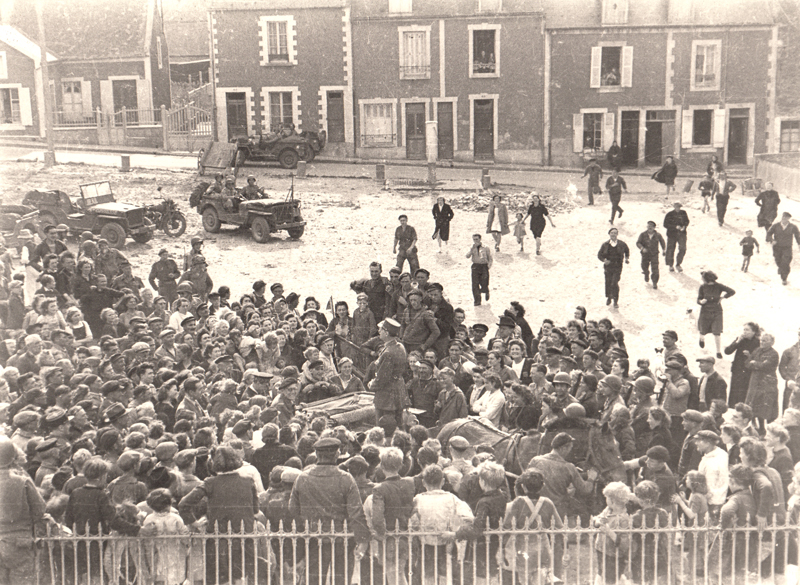
179.1
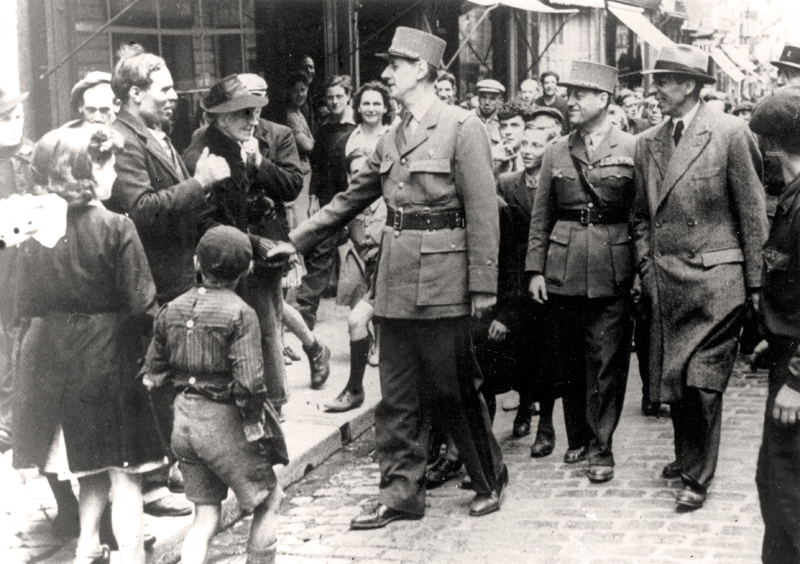
The Anglo-Canadian Sector
De Gaulle Arrives in Normandy
At 1300 hours, off the coast of Graye-sur-Mer, General de Gaulle left the bridge of the destroyer, La Combattante, of the Free French Naval Forces and landed in Normandy. Four years after his departure for London, de Gaulle finally returned to France accompanied by 18 of his principal civilian and military staff. After difficult negotiations with the Allies, the head of the Free French Forces had received authorisation to come to Normandy. On landing, he was met by Major Sanderson who had been sent by Montgomery. De Gaulle immediately visited Montgomery’s headquarters at the Creullet chateau for discussions while the rest of his staff, led by François Coulet and Colonel de Chevigné, headed for Bayeux. Little time was taken in informing the population of a visit by the head of the Free French.
De Gaulle entered Bayeux at 1530 hours and was welcomed by François Coulet and the town council. At the Sub-Prefecture, where the portrait of Marshal Petain was still displayed, he appointed François Coulet as the Premier Commissaire of the Republic and Colonel de Chevigné as military representative of the liberated zone. De Gaulle held a brief meeting with the Sub-Prefect Rochat, to inform him of the situation in the bridgehead, before touring Bayeux on foot. De Gaulle subsequently made his first speech in the liberated zone to a large crowd in the Place du Chateau.
General de Gaulle, left for the front line at Isigny-sur-Mer and Grandcamp-les-Bains before returning to Courseulles by the coast. At nightfall, he embarked, his mission accomplished: to restore, in Normandy, French republican legitimacy, despite the Allies who had kept him at a distance concerning Operation Overlord and a future liberated France.
The Liberation of Lingèvres
Lingèvres, on the advance towards liberating Tilly-sur-Seulles, was a major obstacle for 50th British Infantry Division. In this sector, occupied by the Panzer Lehr, 9th Durham Light Infantry (151st Brigade) was given the mission, on 14th June, of liberating the village. All that was left of Lingèvres was a mass of ruins, after being shelled by the 8 inch guns of HMS Orion. Despite gun fire support from the artillery and fighter bombers, the regiment sustained 246 casualties, including 20 officers, in the liberation of the village. The Panzer Lehr would not give and even launched a renewed counter-attack during the day losing 6 tanks. Five Panther tanks were destroyed by Sergeant Harris of 4th/7th Dragoon Guards with his Sherman Firefly.
The Liberation of Escoville
Escoville, to the south of 6th British Airborne Division’s landing zone, remained occupied by troops of 21st Panzer on the evening of 6th June. The following day’s objective for 2nd Battalion, Ox and Bucks was the liberation of the village. After liberating Herouvillette, the airborne troops entered Escoville on, 7th June, in the morning but later, had to withdraw following a German counter-attack. For a week, Escoville was the front line for the opposing forces. On 14th June, reinforcements from 51st British Infantry Division, after taking up positions to the east of the Orne, liberated Escoville.
The German Forces
The 12th SS Panzer Loses its Chief
Fritz Witt, who had been promoted to brigadier at the age of 35 years, had commanded 12th SS Hitler Youth Division since his arrival in Normandy. Despite the dispersion of his forces and a 12 hour delay in engaging his division on 6th June, Witt was responsible for preventing the Canadians reaching Carpiquet on 7th June. On 14th June, while returning from a daily inspection of his forces, he was killed in the Venoix area of Caen when his command post was hit by a naval shell. General Witt was replaced by his deputy, Colonel Kurt Meyer, who became, at 33 years of age, the youngest divisional commander in the 3rd Reich.
German Destruction of Le Havre
From 14th June, the Allies bombed the port infrastructure at Le Havre and Boulogne. On this day, 350 bombers of the Royal Air Force, destroyed the German naval force based at Le Havre: three destroyers were sunk at their berths, 20 mine sweepers, patrol boats and other craft and 11 torpedo boats, were put out of action. For Admiral Krancke, commander of the Naval Group West, the German naval presence in the Baie de Seine had become virtually nonexistent.
Civilians in the War
The Demise of the Beaucoudray Maquis
Established since April 1944, twenty kilometres to the south of Saint-Lô, the Beaucoudray Maquis, composed of 30 members of the Resistance led by Ernest Pruvost, destroyed telecommunications on the night of 5th-6th June, after having waited for the message to act, enabling the Americans to advance towards Saint-Lô. Isolated, with no hope of reinforcements or of taking up arms, the members of the Resistance hid in a farm at Bois. On 14th June, at 1030 hours, the farm was surrounded by German troops and 11 of the 19 men present, who were members of the group Action-PTT at Saint Lô, were captured. After being assembled in the courtyard of the farm, the group was transferred in the evening to the village of La Réauté. The following morning, they were executed at a site known as “L’oiselière de haut”. The remains of the victims were recovered in August after the liberation.
Vimoutiers and Mézidon Under the Bombs
Vimoutiers which, since 6th June had been occupied by the logistical units of 12th SS Panzer Division, was heavily bombed on 14th June, when, at 0745 hours, 36 Marauder B26 bombers dropped 29 tons of bombs on the village in less than 20 minutes. Incendiary bombs set the town alight, eventually destroying 80% of it and killing 220 civilians out of a population of 1,900. Mézidon, north of Saint-Pierre-sur-Dives, was also bombed killing 50 civilians. Normandy continued to pay a high price for its liberation.
